How to Use a Mac With PowerPoint: A Step-by-Step Guide
Using a Mac with PowerPoint is simple. First, make sure you have PowerPoint installed on your Mac. You can find it at the App Store or through a Microsoft 365 subscription. Open PowerPoint, and you’ll be greeted with a range of templates to start your presentation. From here, you can add text, images, and animations to create an engaging slideshow. Once done, you can present directly from your Mac or save your presentation to share with others.
After you’ve completed your PowerPoint presentation on your Mac, you’ll have a professional and compelling visual aid to support your speech or lecture. You can also share it with others or export it into different formats such as PDF, video, or even a web page.

Introduction
Are you ready to impress your audience with a stunning presentation? If you’re a Mac user, fear not – using PowerPoint on your macOS is as smooth as on any Windows PC. Let’s be honest, presentations are a part of life: whether you’re a student, a professional, or just someone with a story to tell, at some point, you’re going to need to put some slides together. PowerPoint for Mac has all the tools you need to create a presentation that’s both visually captivating and content-rich.
Why is this important? Well, PowerPoint presentations are a staple in the professional world. They’re used for everything from business pitches to academic lectures. Knowing how to create an effective PowerPoint presentation on your Mac could be the difference between persuading your audience or leaving them unimpressed. And who is this relevant to? Everyone! Whether you’re a newbie to presentations or a seasoned speaker looking to refine your skills, this guide will help you master PowerPoint on your Mac.
Step-by-Step Tutorial: Using PowerPoint on a Mac
Before jumping in, let’s clarify what you’ll achieve by following these steps. By the end, you’ll be able to create, edit, and present a PowerPoint slideshow on your Mac.
Step 1: Install PowerPoint
Install PowerPoint on your Mac from the App Store or through a Microsoft 365 subscription.
After installing PowerPoint, you’ll need to sign in with your Microsoft account to activate the software, then you’ll be ready to start creating your presentation.
Step 2: Open PowerPoint
Open PowerPoint and choose a template or open a blank presentation.
PowerPoint offers a variety of templates to suit different presentation styles. If you choose to start with a blank slate, you’ll have complete creative freedom.
Step 3: Add Content
Add slides and content such as text, images, and shapes to your presentation.
Remember to keep your slides simple and not clutter them with too much content. Visual aids should support your speech, not replace it.
Step 4: Customize Your Slides
Customize your slides’ design with themes, colors, and animations.
This step is where you can get creative with your presentation’s look and feel. Just be sure not to go overboard with animations – they should enhance your presentation, not distract from it.
Step 5: Present Your Slideshow
Present your slideshow directly from your Mac or save it to share with others.
You can start your presentation by clicking the ‘Slide Show’ tab and then ‘Play from Start’. Make sure you practice your presentation beforehand to ensure everything runs smoothly.
| Benefit | Explanation |
|---|---|
| User-Friendly Interface | PowerPoint for Mac has a clean and intuitive interface, making it easy for users to navigate and find the necessary tools. |
| Compatibility with Windows | Files created in PowerPoint for Mac are compatible with PowerPoint on Windows, ensuring seamless sharing and collaboration. |
| Multimedia Integration | PowerPoint for Mac allows for easy integration of multimedia elements such as audio, video, and images, enhancing the presentation’s impact. |
| Drawback | Explanation |
|---|---|
| Cost | PowerPoint for Mac requires a purchase or a Microsoft 365 subscription, which may be a barrier for some users. |
| Learning Curve | While user-friendly, new users may still face a learning curve to utilize all the features effectively. |
| System Requirements | PowerPoint can be resource-intensive, potentially affecting performance on older Mac models. |
Additional Information
Now, let’s sprinkle in some extra tidbits that could elevate your PowerPoint game on a Mac. First off, did you know that PowerPoint for Mac supports real-time collaboration? Yup, you can work with your teammates on the same presentation at the same time, no matter where you are. And if you’re all about shortcuts, PowerPoint for Mac has plenty. For instance, pressing Command + Shift + N instantly creates a new slide.
Another neat feature is the Presenter View, which lets you see your notes, the upcoming slide, and a timer, all while the audience only sees the current slide. And for those who value accessibility, PowerPoint for Mac has tools to make presentations more accessible, including options for larger text and high contrast. Just remember, when using PowerPoint on a Mac, you have all the essentials at your fingertips to create presentations that are not just informational, but also memorable.
- Install PowerPoint on your Mac from the App Store or Microsoft 365.
- Open PowerPoint and select a template or start with a blank presentation.
- Add and customize your slides with text, images, and animations.
- Present directly from your Mac or save your presentation for later use.
Frequently Asked Questions
Can i use powerpoint on a mac.
Yes, PowerPoint is available for Mac users and can be downloaded from the App Store or included in a Microsoft 365 subscription.
Is PowerPoint for Mac different from Windows?
While there are some differences in design and available features, PowerPoint for Mac offers a comparable experience to the Windows version.
Can I collaborate with others using PowerPoint for Mac?
Absolutely! PowerPoint for Mac supports real-time collaboration, allowing multiple users to work on the same presentation simultaneously.
Can I open a PowerPoint presentation made on a Mac on a Windows PC?
Yes, presentations made in PowerPoint for Mac are compatible with PowerPoint for Windows, ensuring easy file sharing and collaboration.
Does PowerPoint for Mac support Presenter View?
Yes, Presenter View is available in PowerPoint for Mac, providing speakers with a private view of their notes and upcoming slides while presenting.
In conclusion, mastering the use of PowerPoint on a Mac can be a game-changer for anyone looking to create impactful and persuasive presentations. Whether you’re a student, educator, entrepreneur, or professional, the ability to present your ideas clearly and attractively is invaluable.
So, dive in, explore the features, and harness the power of PowerPoint on your Mac to captivate your audience. Remember, a well-crafted presentation can be the key to success. Happy presenting!

Matthew Burleigh has been writing tech tutorials since 2008. His writing has appeared on dozens of different websites and been read over 50 million times.
After receiving his Bachelor’s and Master’s degrees in Computer Science he spent several years working in IT management for small businesses. However, he now works full time writing content online and creating websites.
His main writing topics include iPhones, Microsoft Office, Google Apps, Android, and Photoshop, but he has also written about many other tech topics as well.
Read his full bio here.
Share this:
Join our free newsletter.
Featured guides and deals
You may opt out at any time. Read our Privacy Policy
Related posts:
- Can I Convert My Powerpoint to Google Slides?
- How to Save Powerpoint as PDF with Notes
- How to Drag Slides From One PowerPoint to Another: A Step-by-Step Guide
- How to Make a Powerpoint Slide Vertical in Powerpoint 2013
- How to Set Time for Slides in Powerpoint
- What Are Benefits of PowerPoint? A Comprehensive Guide
- How to Combine PowerPoint Presentations With Different Orientations
- How to Check Word Count on Powerpoint 2010
- How to Insert Slides from Another Presentation in Powerpoint 2010
- How to Change Hyperlink Color in Powerpoint 2010 (An Easy 5 Step Guide)
- How Is Microsoft PowerPoint Used in Business: A Comprehensive Guide
- How to Unhide a Slide in Powerpoint 2013
- How to Convert a PowerPoint to Word and Edit with Ease
- How to Loop a Slideshow on Powerpoint 2013
- How to: Effortlessly Create PowerPoint Looping Presentations
- How to Change the Font on All Slides in Google Slides
- How to Change Line Spacing in Powerpoint for Every Slide at Once
- How to Insert Check Mark in Powerpoint for Office 365
- How to Start PowerPoint: A Step-by-Step Guide for Beginners
- How to Email a PowerPoint Slideshow: A Step-by-Step Guide
How to Make a PowerPoint on Mac? (A Step-by-Step Guide)
If you’ve ever wanted to create a professional-level PowerPoint on your Mac, you’re in luck! In this step-by-step guide, we’ll walk you through the entire process from start to finish.
You’ll learn what Keynote is and how to open it on your Mac, how to create a PowerPoint, customize the slides, add text, images, and media, utilize themes and animations, and finally, save and share your PowerPoint.
Short Answer
From there, you can select a PowerPoint template and customize it to fit your needs.
What is Keynote?
Keynote provides users with a wide range of tools and features, including customizable slides, themes, animations, and more.
How to Open Keynote on Mac
Opening the Keynote app on a Mac computer is quite simple.
To open the app, you can either use the “Finder” app in your Applications folder, or you can use the “Spotlight Search” tool to quickly find the Keynote app.
From there, you will find the Keynote app.
To do this, click on the magnifying glass icon in the top-right corner of your screen.
You can then type in “Keynote” in the search bar and hit the “Enter” key.
You can customize your slides by adding text, images, and other media.
Creating a PowerPoint on a Mac
Creating a PowerPoint presentation on a Mac computer is a straightforward process, whether youre creating a presentation for work or school.
You can add text, images, and other media to your slides, as well as utilize various themes and animations to make your presentation look professional and eye-catching.
All you need to do is open the app, customize your slides, and then save your presentation in the desired format.
Customizing the Slides
To add text to your slides, simply select the text box and type in your desired text.
Themes allow you to quickly change the overall look and feel of your slides.
Animations can be used to add a touch of flair to your slides, such as transitions between slides and animated text.
Adding Text, Images, and Media
When it comes to creating a professional-looking PowerPoint on a Mac computer, adding text, images, and other media is key.
You can also adjust the font type, font size, font color, and other text properties.
To add images, click the Add Image icon from the top menu, and then select an image from your computer, or add an image from the web.
Finally, you can add other media elements such as audio and video to your slides.
You can also adjust the size, position, and playback settings of the media element to make it look more professional.
By using these methods, you can easily add text, images, and other media elements to your PowerPoint slides on a Mac computer.
Utilizing Themes and Animations
Not only can you easily create a professional-looking presentation, but you can also customize your slides with various themes and animations.
When creating a presentation, you can choose from a wide variety of themes and animations.
For instance, you can use animations to draw attention to a particular slide or element in your presentation.
Creating a professional-looking and engaging presentation on a Mac computer is easy with the help of the Keynote app.
Saving and Sharing Your PowerPoint
You will be given the option to save your file to your Macs hard drive or to the cloud.
If you would like to share your presentation directly with other users, you can do so by clicking the Share menu at the top of the Keynote window and selecting Share with Others.
Here, you can enter the email addresses of the people you would like to share your presentation with.
You can also set a password for your shared presentation if you wish.
The steps outlined above will help you create a great presentation and save/share it with others in no time.
Final Thoughts
So get to it and start making your own PowerPoint today!
James Wilson has extensive knowledge in the information technology industry.His second love, besides dealing with computers, is smart home technology. He is continually updating information to better comprehend this problem and has a deep understanding of the apartment’s support system.
Recent Posts
- Microsoft's Promise of Easy AI
- Walmart's Killer Tech Deals This Week
How to Get PowerPoint on a Mac
Get the widely used presentation tool
:max_bytes(150000):strip_icc():format(webp)/SamCostello-d7fcf106ec2048ccb06d1e2190b3396d.jpg)
- Ithaca College
:max_bytes(150000):strip_icc():format(webp)/ryanperiansquare-de5f69cde760457facb17deac949263e-180a645bf10845498a859fbbcda36d46.jpg)
- Western Governors University
What to Know
- From the Mac App Store: Apple Menu > App Store > search for PowerPoint > Get > Install > enter Apple ID if prompted > Open .
- PowerPoint requires a subscription from Microsoft. You can sign up via In-App Purchase or at the Microsoft website.
- Keynote, Apple's alternative to PowerPoint, comes pre-installed on new Macs (and can be downloaded from the Mac App Store).
This article explains how to get PowerPoint on Mac, its requirements—including a subscription—and some free alternatives available on the Mac.
How Do I Get PowerPoint on Mac?
Getting PowerPoint on your Mac is very easy. Just a few clicks, and you'll be ready to start making slides and building presentations. Here's what to do:
Open the Mac App Store by going to the Apple menu > App Store or the Applications folder > App Store .
You can also download PowerPoint directly from Microsoft , but these instructions focus on the Mac App Store.
Search for PowerPoint .
On the search results screen, click Get .
Click Install .
Enter your Apple ID password when prompted.
When the download is finished, click Open to launch PowerPoint.
Once you've opened PowerPoint, you'll need to sign into your Microsoft account or use a free trial.
Is PowerPoint Free for the Mac?
PowerPoint is not free on the Mac (or on Windows, for that matter). Microsoft offers a free, 30-day trial after you download PowerPoint. Once the free trial expires, you need to pay to keep using the app. Options include a one-time purchase price or a monthly or annual subscription , which provides cloud storage features and ongoing technical support. You can subscribe through Microsoft's website or use in-app purchases via your Apple ID.
Do Macs Come With PowerPoint?
No. To get PowerPoint on your Mac, you need to download and install it using the steps from the first section of this article (or, as noted before, directly from Microsoft).
What Is the Mac Version of PowerPoint?
While PowerPoint may be the most well-known program for making slides and creating presentations, it's far from the only one. Your Mac probably came with one of the alternatives pre-installed.
Apple makes a program called Keynote which is a direct competitor to PowerPoint. It offers all of the core features of PowerPoint—creating slides and presentations, animations, templates, presenter mode, etc. It integrates tightly with Apple's other software and services like iCloud.
Keynote comes pre-installed for free on all modern Macs. It's likely in your Applications folder as you read this. If it's not, and if your Mac and version of the macOS are compatible with it, you can download it for free from the Mac App Store by searching for "Keynote."
Need to make slides and want to avoid both PowerPoint and Keynote? There are many other PowerPoint alternatives , but one place to start is Google Slides , which is free, web-based, and integrates with your Google account and other Google productivity tools.
To print PowerPoint slides with Notes on a Mac, open your presentation and select Print . In the Print dialog box, select Show Details . In the Layout box, select Notes . Configure the rest of your printing options and select Print .
The easiest way to record a voiceover in PowerPoint on a Mac is to record by slide. Select the slide where you want to add the narration, then select Insert from the menu bar and click Audio > Record Audio . Enter a name for the narration, select Record , read your script, and select Stop when you're finished recording.
To convert PowerPoint to video on a Mac, open the presentation you want to save and select File > Export . In the export window, next to File Format , select a file format option, such as MP4 or MOV . Choose your video quality, choose whether you want to include narrations, adjust timing, and select Export .
Get the Latest Tech News Delivered Every Day
- How to Update a Mac
- How to Install Mac OS on PC
- How to Use Copilot in Powerpoint
- What Is Microsoft PowerPoint and How Do I Use It?
- The Best Free Productivity Apps for the iPad
- 4 Ways of Transferring Files From Android to Mac
- How to Update Messages on a Mac
- How to Use WhatsApp on a Mac
- How to Use Microsoft's Free PowerPoint Viewers
- How to Convert PowerPoint to Video
- How to Update PowerPoint on Windows and Mac
- What Is Microsoft Word for Mac?
- How to Transfer Files Between an iPhone and a Mac
- What Is an Animation in Presentation Software?
- The 10 Best Word Processing Apps for iPad in 2024
- How to Remove Adware From Your Mac
PowerPoint for Mac: Best tips for a successful presentation
- 0 Shares Share

The maxim of “Death by PowerPoint” does not fit in today’s tech-savvy era. Numerous startups and corporates pitch their ideas to their clients through presentations every day. They leverage stunning templates to design them and sweep their stakeholders off their feet. Slideshows hold an enormous audio-visual appeal that helps you to hook your audience throughout.
Whether it is Keynote or PowerPoint, showcasing a slideshow on your Mac must appear seamless. Be it slide layout, design, visuals, or overall aesthetics, a collection of well-thought, pixel-perfect slides is the key to presentation success. So, how to craft splendid and eye-catching Mac presentations? This article will enlighten you perfectly. Let us begin!
Here are seven best tips for creating successful and compelling presentations on your Mac:
Minimalistic slides
Gone are the times when people assumed that designing a ppt meant overloading it with information. You’ll be doing your audience a huge favor if you opt for minimalism in your slide content. Often presenters overload the slides unnecessarily and thus, end up overwhelming the audience. Embed your decks with one topic per slide. Ensure that you build your pitch decks with less text and more graphics. Keeping the slide content simple and precise will bestow your MAC slideshow with a decluttered look. It will help you to further your brand aesthetics as well.
You may consider following the famous 10-20-30 rule of PowerPoint presentations. The rule states that your presentation should be no longer than ten slides. It must not take beyond 20 minutes to deliver the entire presentation. And at last, the slides should feature a font size of at least 30 px. The revolutionary 10-20-30 rule helps you keep your slides minimalistic, deliver a captivating presentation and engage with the audience like never before.
Engaging multimedia
Humans have a limited attention span. Keeping this in mind, you must always integrate enchanting visuals to liven up your presentation. Employ vector images, 1080p videos, infographics, and GIFs to render the slides attractive. The truth is, no one likes to read raw data right off the slides! As a presenter, you should consider transforming raw data into engaging visuals that bind the interest of the audience to the presentation.
The incorporation of audio and other media forms assists you with a seamless slideshow. You can infuse your slides with visuals corresponding to your presentation topic. It will work as a double-edged sword. First, it will garner your slides appealing. Second, it will reinforce the textual content in your audience’s minds as well. Hence, slides without dedicated multimedia contribute to the phenomenon ‘Death By PowerPoint’.
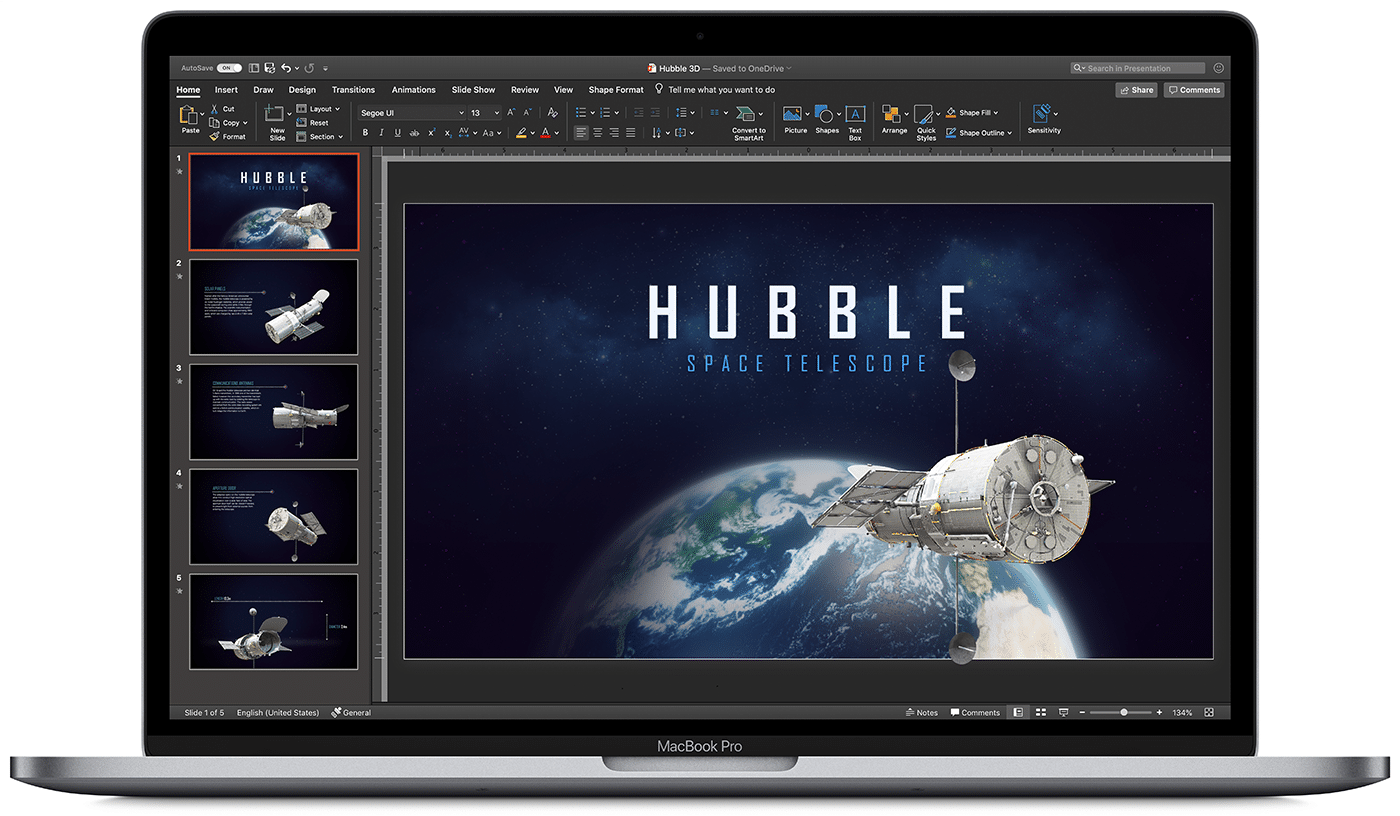
Top-notch templates
Breaking the monotony of stock templates in your Mac is essential to stay a step ahead of your competitors. Utilizing age-old templates will not impress your clients as effectively as you desire. There is a high chance that your audience is already familiar with the stock template from some other presentation. Hence, the wow factor goes for a toss!
Well, you can leverage ready-to-use PowerPoint templates from SlideModel that offer 100% customization, superior graphics, and pixel-perfect design. Users can utilize the avant-garde slide templates to boost their presentation goals. The goal here is to woo the audience with your presentations’ design! Gorgeous graphics and tailor-made slide content will save your precious time from making a presentation from scratch. This business Pitch Deck PowerPoint Template is a boon for all entrepreneurs to construct wow-worthy pitches.
Elegant color-palette
An excellent way to highlight the key points of your Mac slideshow is to create a color contrast on the slides. You can design your slides in relevance to your brand colors or choose a vibrant color scheme. A golden tip here is to blend your presentation with high-contrast colors. It will aid you and your audience in capturing the slide essence. Place the dark-toned text with a light-toned background and light-colored slide content on a dark background. It will bring out the effect of aesthetic contrast.
A great tip here is embedding your presentation with your brand colors for making it impressive beyond measure. Choose only two to three colors throughout to maintain an equilibrium. One should try not to use all the contrast colors to attract the audience. Design consistency in your slides is a key to presentation success. Rather than overwhelming the audience with different high-contrast, mismatching colors, try to include a couple of color schemes and palettes across your presentation.
Captivating data visuals
Whether you’re presenting to an assembly of investors, pitching to a client, or presenting a company’s quarterly results, always back your data with rich visuals. Rather than reading random numbers from the slides, you should introduce a wow factor to your slides by leveraging state-of-the-art data visualizations. Render your PowerPoint presentations on Mac an awe-inspiring look with data visuals such as 3D charts, diagrams, infographics & graphs.
Display your research and statistics with mind-blowing data visuals. Employ alluring charts, tables, diagrams, trend lines, shapes, and infographics. You can color-code them to show comparisons and differences. Choose data visuals for bullets to leave an indelible mark on your audience. Projecting data with these tools helps your clients to retain information and comprehend it as well. SlideModel offers innumerable templates with exemplary data visuals for influencing the audience.

Hierarchical structure
Many people do not know the fact that information displayed first captures the attention of your audience before others. Thus, visual hierarchy is a way to organize your slide content based on its importance. Every presentation is intended to initiate a call-to-action amidst the audience. Presenters can reinforce the critical subject content through rich hierarchical structures. Prioritize placing the slide content in a manner that you want your clients to see initially.
Recognize the slide elements in the order of their significance and place them accordingly. Use good contrast placements, bolder texts, and large visuals. This way, your stakeholders will view your highlighted information first and then move to the other content. Hence, with your presentations, be it remote or in-person, you can encourage your audience to close the deal with you rather than missing the opportunity.
Master the typography
Every slideshow looks tidy when crafted with good typography. Apply corporate-grade typography fonts such as Helvetica instead of unprofessional or artistic Comic Sans. It assists in keeping easy readability for your slide content, plus helps in boosting the integrity of the content. Remember to place the size of your fonts as 30 px or more for your audience in the back as well. You won’t want your audience to squint their eyes while seeing your ppt.
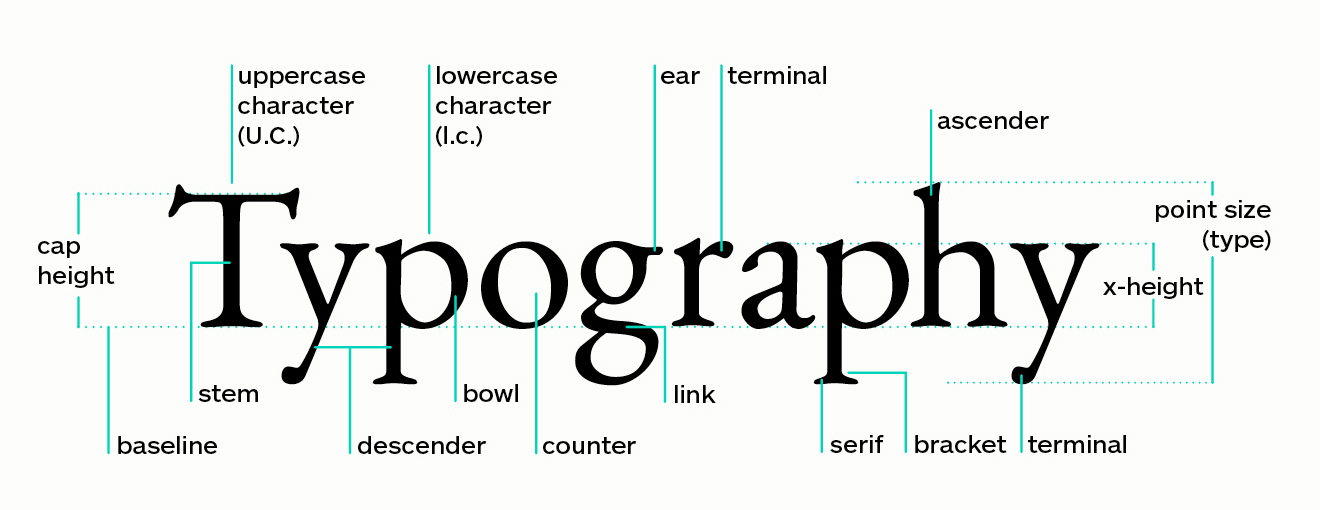
As a presenter, you should always take care of the content length. One should avoid typing hefty paragraphs. Instead, go for one-liners and bullets. You may use six bullet points in each slide. Another great tip is to position the title of your slide to a slightly bigger font than the text. While presenting, you can further elongate the one-liners and help your audience understand the crux of the subject matter without throwing them off the track.
Mac PowerPoint presentations having a beautiful style can result in having a colossal effect on your audience. A well-crafted PowerPoint presentation can be a deciding factor between a closed deal and a missed opportunity.
Keep these seven enlightening and professional tips in your mind before structuring your next ideal presentation. Integrate a pinch of style, creativity, and vigor in your slide deck to create modernistic slides. The key is to attract your audience with minimalistic, yet engaging slide content.

News content on AppleMagazine.com is produced by our editorial team and complements more in-depth editorials which you’ll find as part of our weekly publication. AppleMagazine.com provides a comprehensive daily reading experience, offering a wide view of the consumer technology landscape to ensure you're always in the know. Check back every weekday for more.
Editorial Team | Masthead – AppleMagazine Digital Publication
- @http://twitter.com/applemagazine
- Follow me on Facebook
- Send me an email!
Related Stories
Can apple become a console gaming giant, apple rolls out new features for iwork suite across mac, ipad, and iphone, the lowdown on applecare+ (is it worth buying), demystifying apple pay: your ultimate guide, security features that keep your apple devices safe, apple set to discontinue ‘my photo stream’ service in july 2023, end of an era: apple infinite loop store shuts down, apple unveils ‘vision pro’ headset & visionos, why apple devices are better for media production, apple showcases ‘scary fast’ event filming techniques with iphone 15 pro max, you may also like.

12 Ways to Personalize Apple Watch

How Tenant Insurance Protects Your Belongings

3 Gadgets to Enhance your Gaming & Online Casino Experience
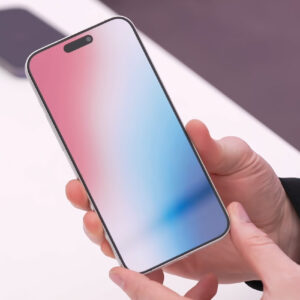
Exploring iPhone 16’s Anticipated New Features

Streamlining App Development: The Benefits of Low-Code Platforms

Staying Connected: Characteristics of Truly Reliable Internet
- Editorial Process
- Why Trust Us?
- Affiliate Linking Policy
- Privacy Policy
- Terms of Service
Weekly Must-Reads View All
7 things to do if you spilled water on your macbook.
Quick steps to save your MacBook from water damage
How to Boot Your Mac Into Verbose Mode: 4 Best Ways
Boot your Mac into Verbose Mode with this step-by-step guide
How to Fix Your Mac Shutting Down Randomly: 16 Fixes to Try
Troubleshoot random shutdowns on Mac with effective solutions
How Much Space Does macOS Take On Your Mac?
Understand macOS size and analyze your Mac's storage usage
Popular Topics
- What to Do With Your Old MacBook? 13 Useful Ways to Reuse an Old Mac
- What Is the MacBook Flexgate Issue and How to Fix It
- What Is the MacBook Flexgate Issue
- Uninstall Java
- Safely Transfer Files from Mac to Mac
- Safari Bookmarks Disappeared on Mac: 10 Best Ways to Restore Them
- Repairing disk permissions
- Old MacBook
Trending Now View All

- Mac Tips and Tricks
How to Make a Slideshow on a Mac: 3 Quick Ways
Hashir Ibrahim
Reviewed by
Last updated: November 13, 2023
Expert verified
To make a slideshow on a Mac, use built-in tools like the Photos app, Preview, and Keynote, each offering unique features and levels of customization.
- Create instant and custom slideshows with music and themes using the Photos app.
- Make more intricate presentations with text, transitions, and multimedia integration using Keynote.
- Preview app, known for viewing and annotating PDFs and images, also offers a basic slideshow feature for quickly viewing images.
Ever wanted to transform your photos into a captivating visual story on your Mac? Whether it’s for that big presentation, a personal diary, or simply reliving holiday memories, a slideshow can bring your vision to life.
With your Mac’s intuitive tools, creating a slideshow becomes easy and fun. In this guide, I’ll unveil the quickest ways to make a slideshow on a Mac. Ready to impress and express? Let’s dive right in!
How to Make a Slideshow on a Mac
Mac offers an unparalleled platform for creating slideshows. Below, I’ve shared three quick and easy ways to make a slideshow on a Mac.
1. How to Create a Slideshow in Photos
The Photos app on Mac lets you easily create slideshows. You can select a series of photos, arrange them in a sequence, add music, and choose from various themes to give the slideshow a professional touch. Once created, you can preview the slideshow, export it as a video, or share it directly from the app.
a. Create an Instant Slideshow in Photos
Here’s a step-by-step guide on how to create a slideshow using the Photos app on a Mac:
- Launch the Photos app by searching for it in Spotlight search.

- Navigate to the photos you want to include in your slideshow. You can select individual photos by holding down the Command ⌘ key while clicking each photo. To select a range, click the first photo, hold down the Shift ⇧ key, and click the last photo in the range.
- With your photos selected, click File in the menu bar and choose Play Slideshow .

- A new pop-up menu will appear. You can choose a Theme and Music for your slideshow. Once you’re done, click the Play Slideshow button.
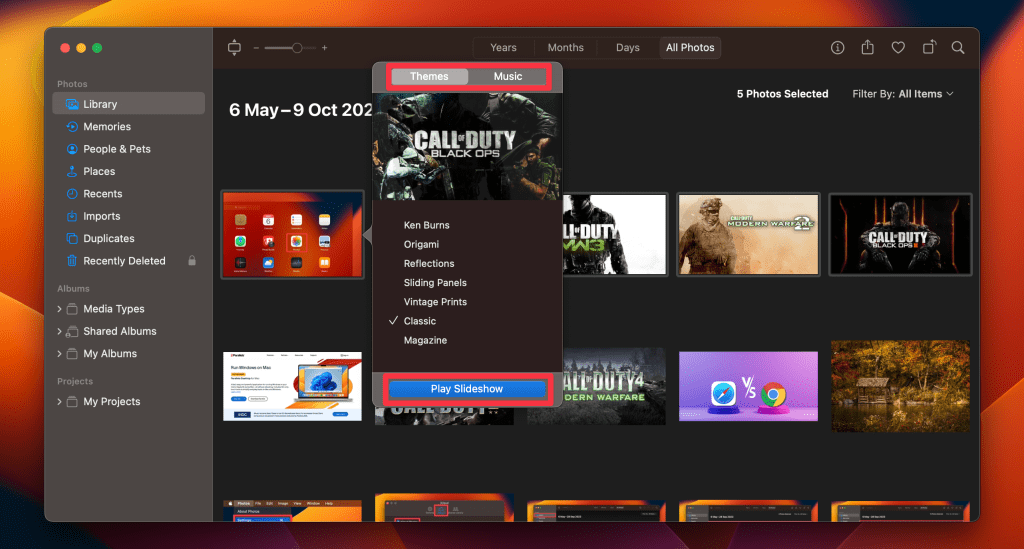
- It will start the slideshow in fullscreen.
- You can navigate the slideshow using your keyboard. Press the left and right arrow keys to switch between slides. Tap the Spacebar to stop the slideshow and the Escape key to close it.
b. Create a Custom Slideshow in Photos
You can use the slideshow project tool within the Photos app to create a custom and more sophisticated slideshow with enhanced configurations and playback features. This lets you organize slides, incorporate text, embed music, fine-tune slide timings, and save and export the video.
Here’s how to create a custom slideshow in Photos:
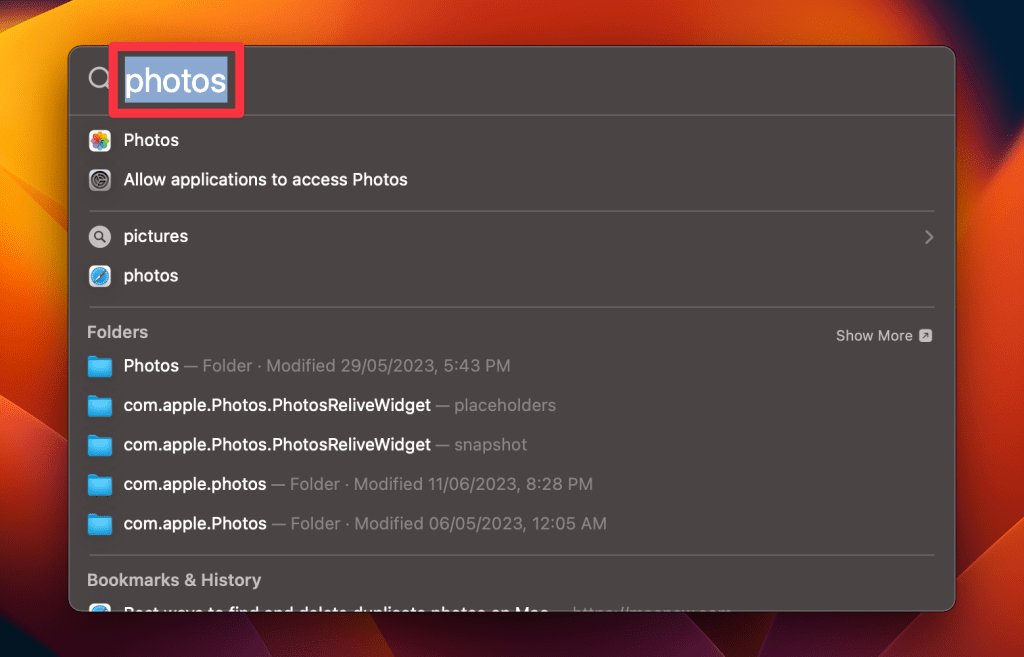
- Click File in the menu bar and navigate to Create > Slideshow > Photos .

- A new window will appear. Select New Slideshow from the dropdown and give the slideshow a name. Then, click OK .
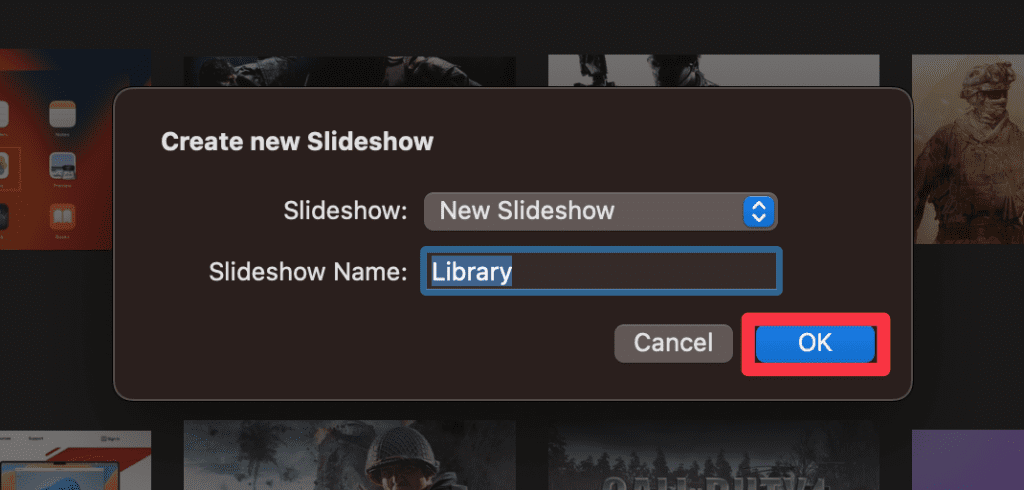
- Select the photos you want to include in the slideshow and click the Add button in the top-right corner.
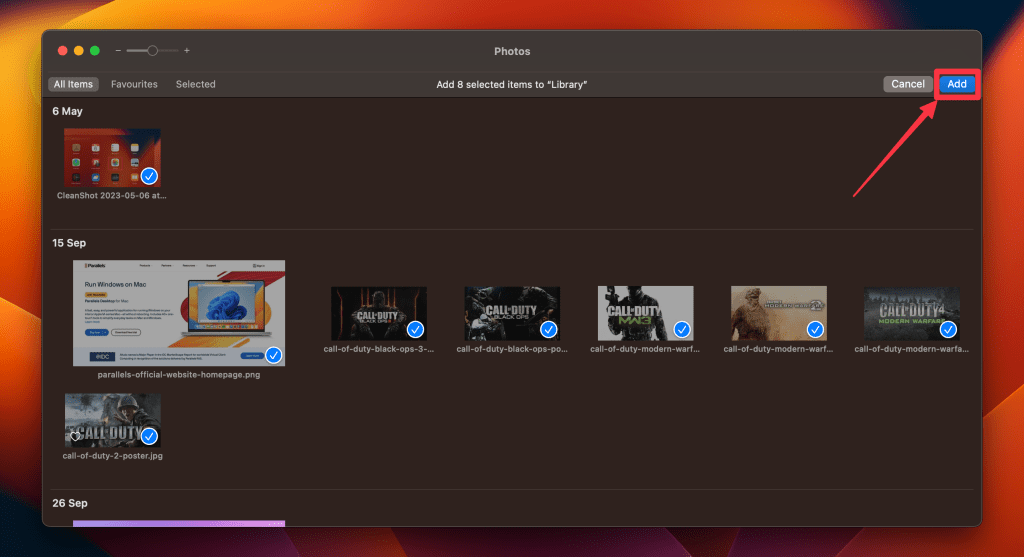
- To customize your slideshow’s appearance, you can click the icons in the right strip.
- To modify slide transitions, positioning, font style, and zoom level, click the Theme icon and pick from the list.
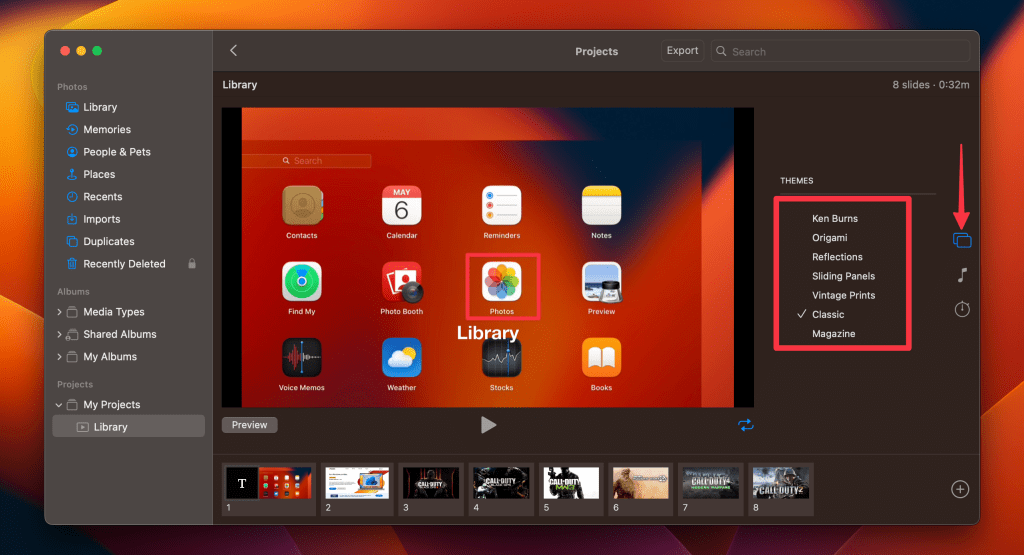
- Click the Music icon to select your slideshow’s music.
- To tweak the slideshow’s length, access the Duration menu and drag the Custom slider. Alternatively, check the Fit to Music feature to synchronize the slideshow’s duration with your chosen soundtrack.
- Configure transitions via the Transition dropdown, which will be applied to all slides.
- Check the Scale photos to fit screen option to ensure images are displayed optimally.
- Activate the Loop feature if you want the slideshow to replay indefinitely, restarting after the concluding slide.
- Click the Preview button to view your slideshow. Click it again to stop the slideshow.

- The Play button also initiates the slideshow.
- To exit the slideshow, press the Escape key.
How to Add or Remove Photos and Text in a Slideshow on Mac
You can also customize slideshows on your Mac. Here’s how to add or remove photos and text in a slideshow on Mac:
a. Adding Photos
- Launch the Photos app and open your slideshow.
- Click the + (plus) icon at the bottom-right corner of the slideshow.
- Select the Add Photos option from the menu that appears.
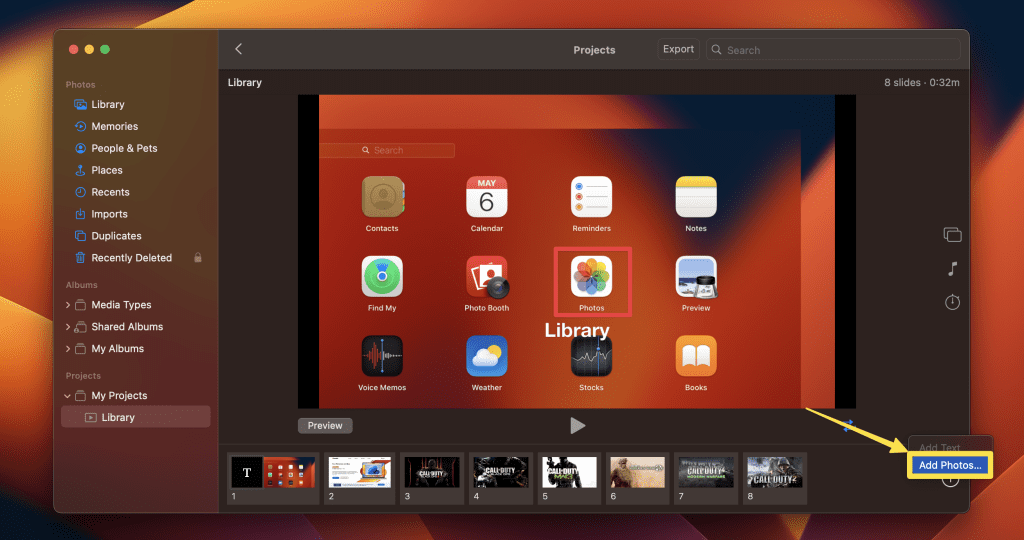
b. Removing Photos
- Navigate to the slide containing the photo you want to remove.
- Right-click the photo and select Delete Slide .
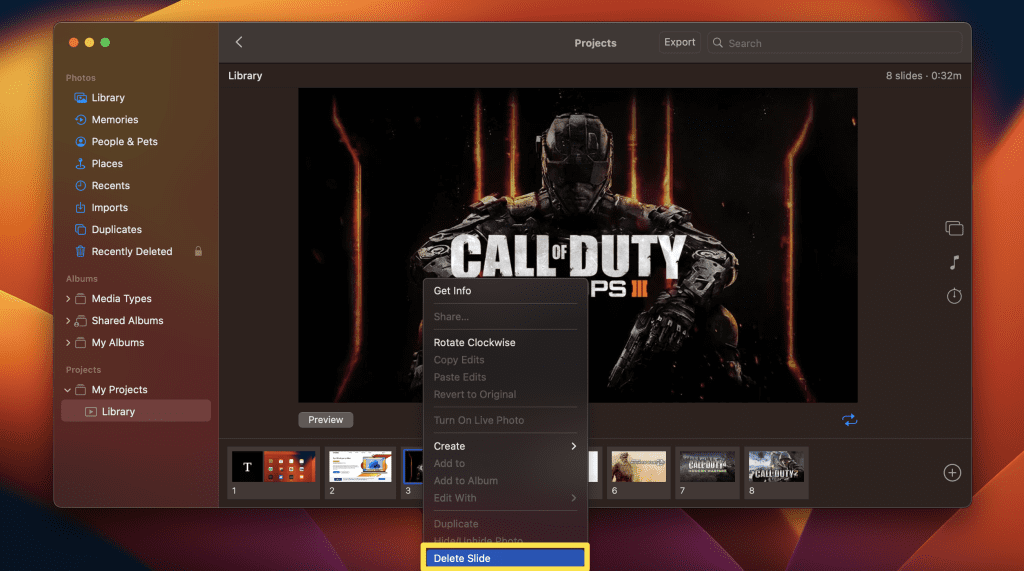
c. Adding Text
- Open your slideshow and select the slide you want to add text to.
- Select Add Text from the menu.
- A text box will appear on your slide. You can modify the Default Text by clicking it and typing your desired text.
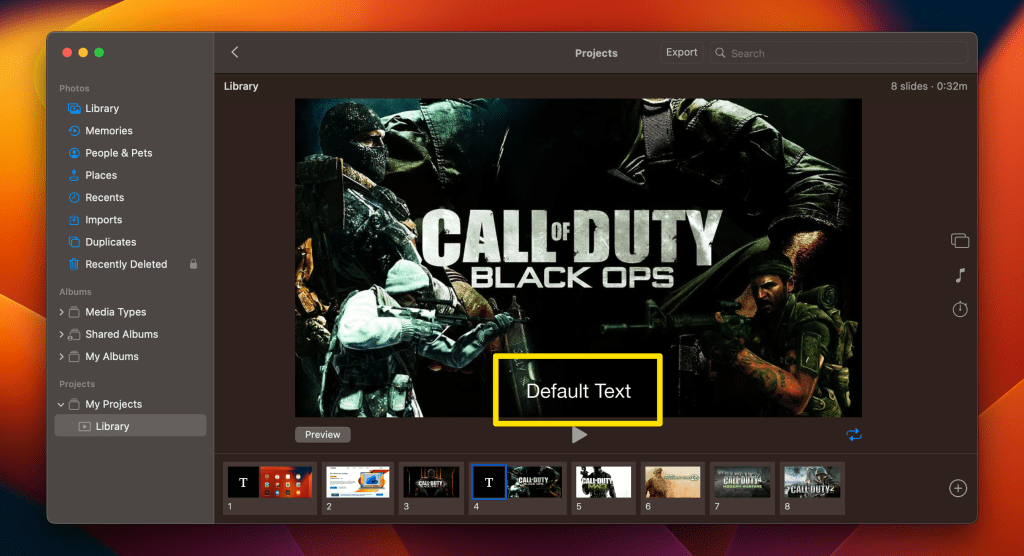
d. Removing Text
- Navigate to the slide with the text you want to remove.
- Click the text box to select it or the T icon preceding the photo in the thumbnail lineup, and hit the Delete key.
- Alternatively, right-click the T box and select Delete Text .
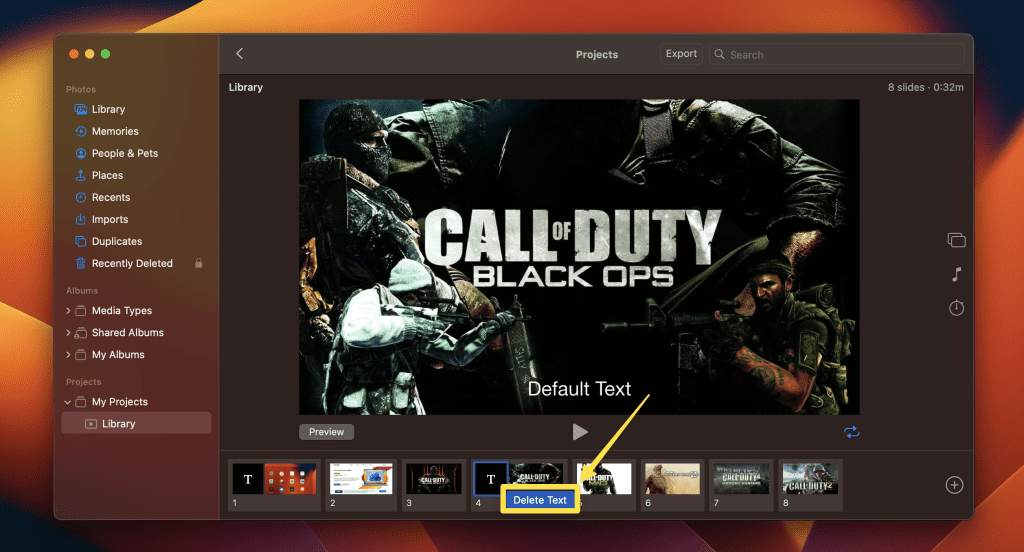
2. How to Make a Slideshow on a Mac With Preview
The Preview app on a Mac is primarily known for viewing and annotating PDFs and images. However, it also offers a simple slideshow feature. While it doesn’t have the advanced customization options found in dedicated slideshow software, it’s perfect for quickly viewing a series of images in a slideshow format.
Here’s how to make a slideshow on a Mac in the Preview app:
- Launch the Preview app from the Dock or the Applications folder.

- A new window will open. Navigate to the location where your images are saved and select the ones you want in a slideshow. Click Open .
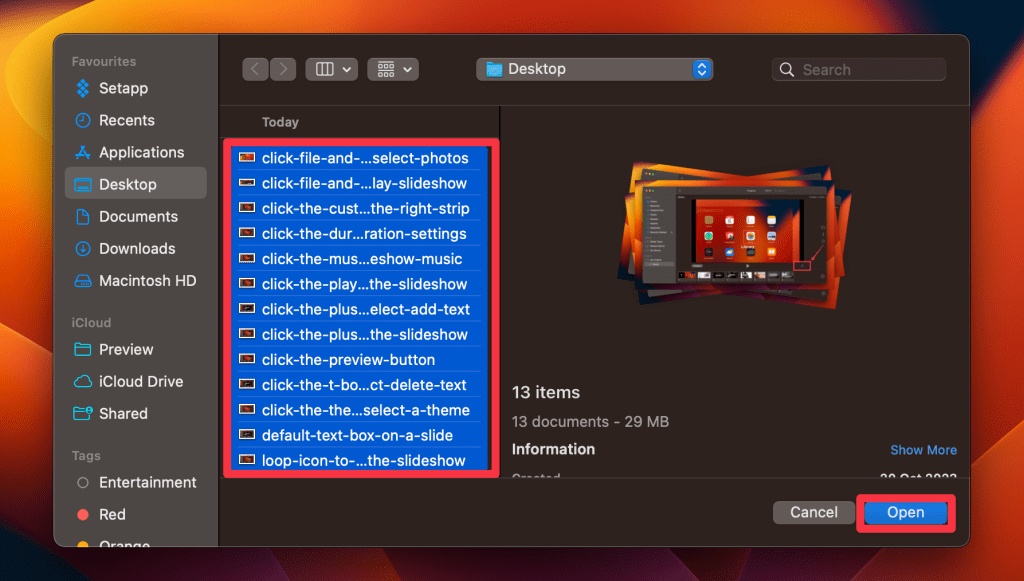
- This will open all selected images in a Preview window. Select all the images in the left sidebar by pressing Command ⌘ + A .
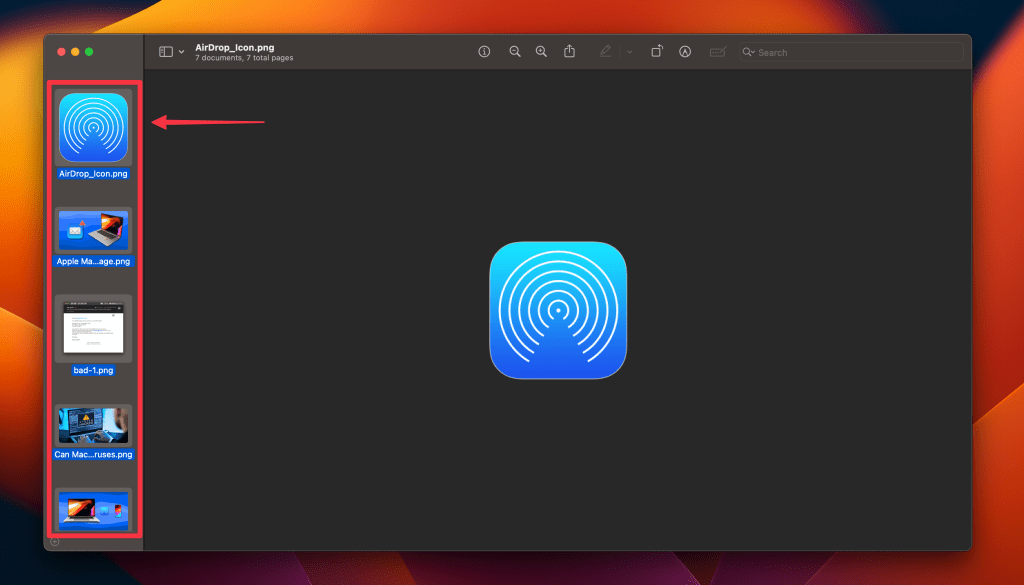
- With all your images open in Preview, go to View in the menu bar and select Slideshow .

- Navigate through the slideshow using the left and right arrow keys on your keyboard.
- Press the Spacebar to pause or play the slideshow.
- Use the Escape key to exit the slideshow.
3. How to Make a Slideshow in Keynote
Keynote is Apple’s answer to presentation software and is known for its sleek designs and smooth animations. While primarily used for presentations, it’s also an excellent tool for creating slideshows, especially if you want to incorporate text, transitions, and other advanced features.
Here’s how to make a slideshow on a Mac using Keynote:
- Open Keynote by searching for it in the Spotlight search.
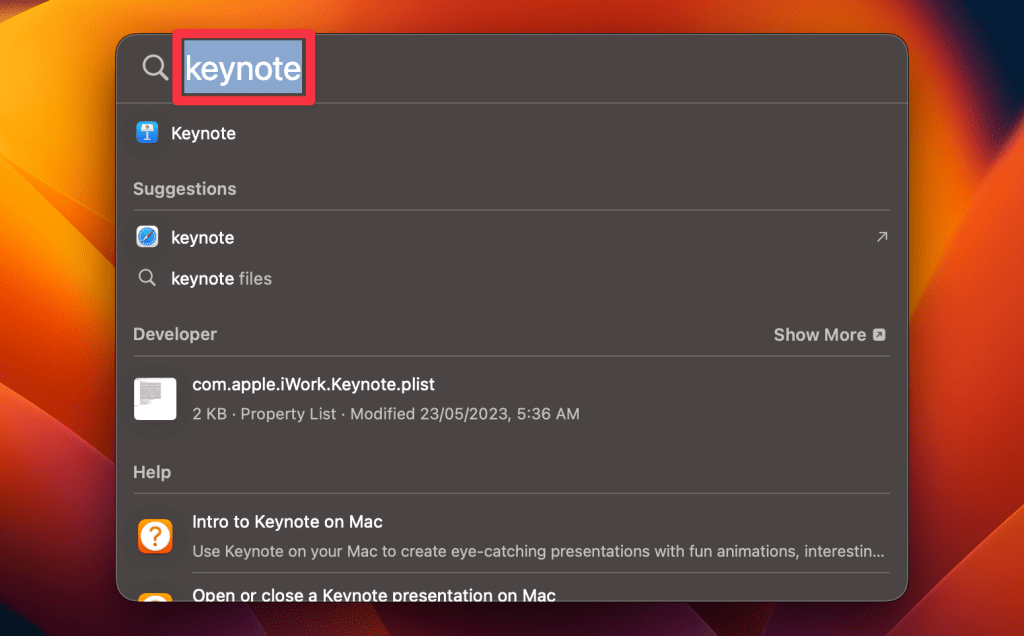
- Upon opening, Keynote will present you with various templates. Choose one that fits the style of your slideshow.
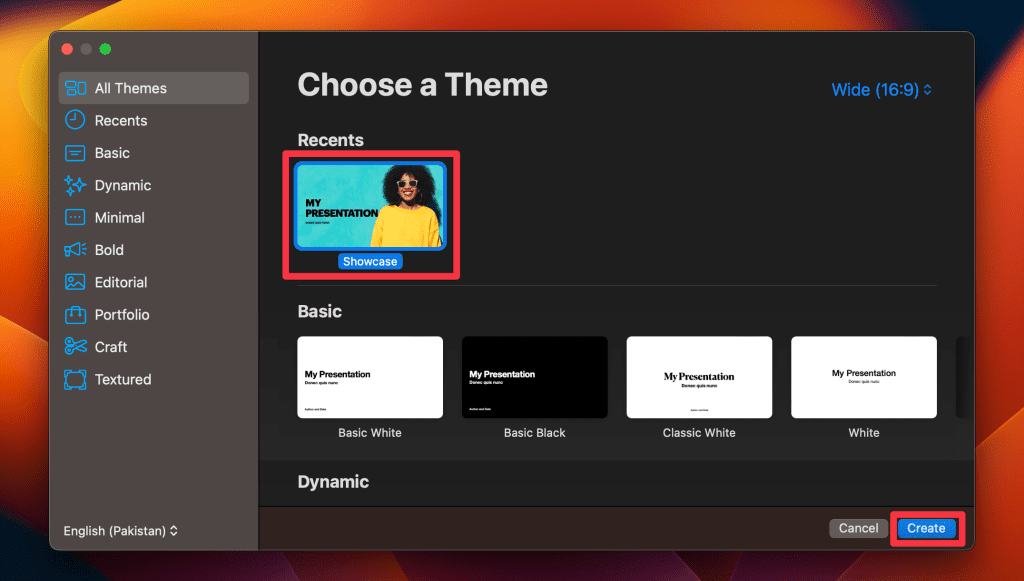
- Click Slide in the menu bar and select New Slide .
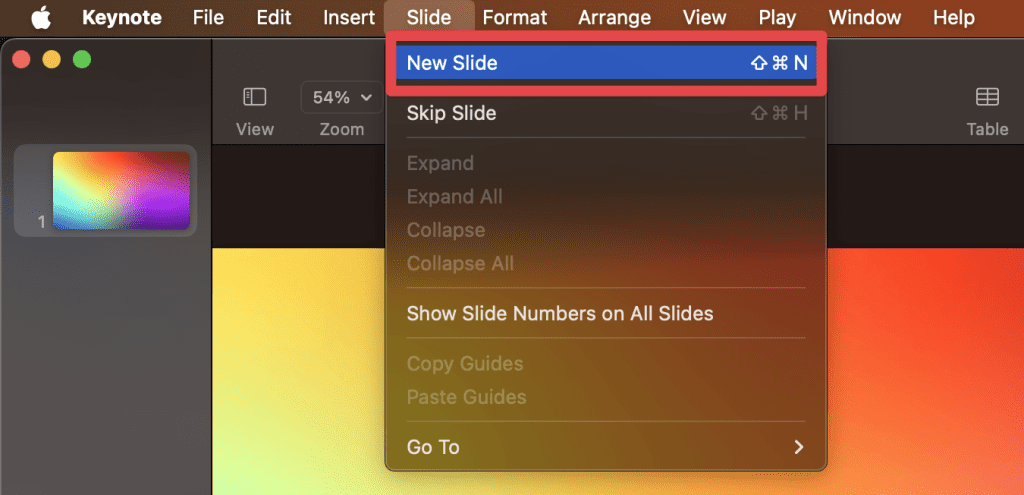
- Alternatively, click the Add Slide button in the top toolbar.
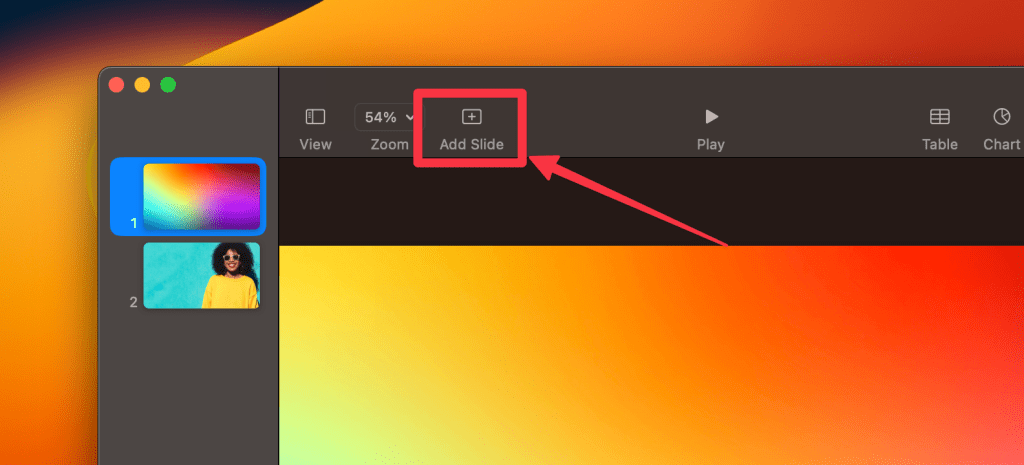
- You can choose different slide layouts based on content (e.g., title slides, content slides, photo slides).
- Drag and drop photos, videos, or text into the slide placeholders.
- Use the Media button in the toolbar to insert images, videos, and music directly from your library.

- Click a slide, then choose the Animate button in the toolbar.
- Select Add an Effect to choose from various slide transitions. You can also add object animations for individual elements within a slide.

- If you want the slideshow to play automatically, go to Document > Document in the top right corner and check Automatically play upon open . Adjust the slide duration as desired.

- Click the Play button in the top toolbar to view your slideshow.
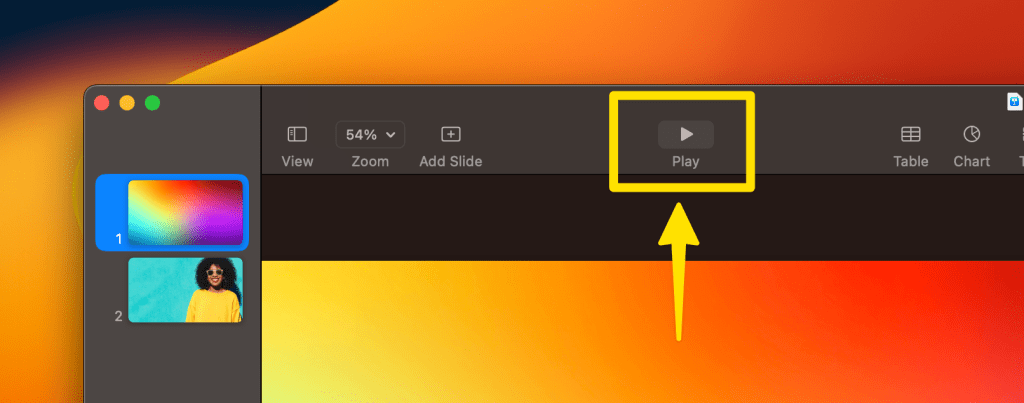
- Save your project by going to File > Save .
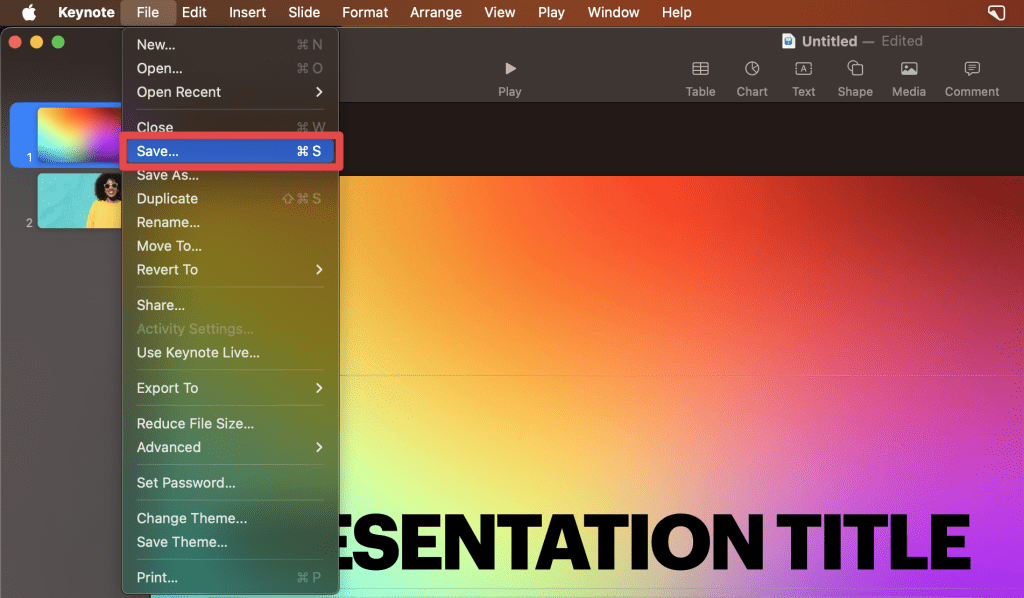
- To export the slideshow as a video or another format, go to File > Export To and choose your desired format.

Why Make a Slideshow on a Mac?
Making a slideshow on a Mac not only provides a seamless experience but also ensures a polished and professional outcome. Creating a slideshow on a Mac offers several advantages, like the following:
- 🖥️ User-Friendly Interface : Mac’s operating system, macOS, is known for its intuitive and user-friendly design. This makes the process of creating slideshows straightforward, even for beginners.
- 🌈 High-Quality Graphics : Mac computers are renowned for their superior display quality. This ensures that your slideshows will look crisp, vibrant, and professional.
- 📦 Integrated Software : Macs come with pre-installed software like iMovie and Photos, which offer slideshow creation tools. This means you don’t need to invest in additional software.
- ✨ Customization : With a Mac, you have a plethora of customization options at your fingertips, from transitions to music integration, allowing for a personalized touch.
- ☁️ Seamless Integration : If you’re using other Apple devices, such as an iPhone or iPad, you can easily sync and share your slideshows across devices via iCloud.
- 🎥 Multimedia Capabilities : Macs handle multimedia content efficiently, allowing you to incorporate videos, music, and high-resolution images without compromising performance.
- 🔒 Security : macOS is known for its robust security features, ensuring that your content remains safe from potential threats.
Create Slideshows on Your Mac Quickly
Whether you’re using the Photos app for a quick and simple presentation, Preview for a rapid image display, or Keynote for a more intricate and interactive experience, Mac ensures a seamless and efficient process.
Here are some more tips for you:
- If you want to add a voice-over to your slideshow, learn how to record audio on your Mac .
- If you want to upload a slideshow video to your social media, you might have to compress a video on Mac .
- You can take a screenshot on your Mac and add that to a slideshow.
Frequently Asked Questions
How do i delete a slideshow on mac.
To delete a slideshow on Mac, locate the specific slideshow file or project in the relevant application (e.g., Photos or Keynote). Right-click it and select Move to Bin or Delete . Empty the Bin on your Mac to permanently remove it from your Mac.
Can I add animations to my slideshows on Mac?
You can add animations to your slideshows on Mac using Keynote. Keynote offers a variety of transition effects and object animations, allowing you to enhance your presentation and make it more dynamic and engaging. However, you cannot add animations in Photo app slideshows.
Can I share my slideshow on social media?
Yes, you can share your slideshow on social media. Most slideshow creation tools on a Mac let you export your project as a video or link. Once exported, you can easily share it on various social media platforms like Facebook, Instagram, Twitter, and more.

How do I export my slideshow as a video?
To export your slideshow as a video, open the slideshow software, navigate to the File menu, select Export or Export To , and choose the Video option. Follow the prompts, adjust settings as needed, and save the video to your desired location.
Can I add videos to my slideshow on Mac?
You can add videos to your slideshow on Mac. Applications like Keynote and the Photos app support video integration, allowing you to enhance your presentation with dynamic video content alongside images. It’s a great way to make your slideshow more engaging and interactive.
Can I add text to my slides on Mac?
Yes, you can add text to your slides on Mac using slideshow applications, like Keynote and Photos. Simply select the desired slide, click the Add Text or similar option, and input your text. Customize fonts and styles for a personalized touch.
I'm Hashir, a tech journalist with a decade of experience. My work has been featured in some of the top tech publications like MakeUseOf and MakeTechEasier. I have a bachelor's degree in IT, a master's in cybersecurity, and extensive knowledge of Apple hardware, specifically MacBooks. As the senior writer at MacBook Journal, I write in depth guides that help you solve any issues you have with your mac and unbiased reviews that help you make the right buying decisions.
Hi there! I'm Ojash, a tech journalist with over a decade of experience in the industry. I've had the privilege of contributing to some of the world's largest tech publications, making my mark as a respected Mac expert. My passion lies in exploring, using, and writing about MacBooks, and I enjoy sharing my expertise to help others make informed decisions and get the most out of their MacBook experience. Join me as we delve into the fascinating world of MacBooks together!
You May Also Like
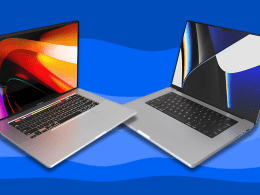
All MacBooks Ever Released In Order: A Comprehensive Guide
Written by Hashir Ibrahim Reviewed by Ojash Last updated: September 6, 2023

How to AirDrop From iPhone to Mac
Written by Hashir Ibrahim Reviewed by Ojash Last updated: October 14, 2023

MacBook Users by Country: Mac Market Share Around the World
Written by Hashir Ibrahim Reviewed by Ojash Last updated: September 14, 2023
How to download and access Microsoft PowerPoint on your Mac computer
- You can download Microsoft PowerPoint on your Mac computer in the App Store.
- You need to have a Microsoft Office 365 trial or subscription in order to use PowerPoint on your computer.
- Visit Business Insider's homepage for more stories .
Microsoft's leading presentation tool, PowerPoint , is part of Office 365 , which also includes Word, Excel, Outlook, OneNote, and OneDrive.
To download and access PowerPoint on your Mac , follow these steps below.
Check out the products mentioned in this article:
Macbook pro (from $1,299.99 at best buy), microsoft office 365 - personal (from $69.99 at best buy), how to download powerpoint on your mac.
1. Launch the App Store on your Mac computer.
2. In the search bar on the left, type in "PowerPoint."
3. The first search result should be for Microsoft's PowerPoint. If not, toggle through the results to find it. Next, click "Get" and then "Install."
4. Sign in using your Apple ID information, if needed, to initiate the download. Then, select "Get" at the bottom.
5. The PowerPoint app will then begin to download. When finished downloading, select "Open" in the top-right hand corner.
6. Select "Get Started" in the pop-up to sign in using your Microsoft credentials or to start a free one-month trial.
Related coverage from How To Do Everything: Tech :
How to get your mac computer to read text aloud, how to delete an administrator account on your mac computer, how to crop a video on your mac computer using imovie, how to download and install mozilla firefox on your mac computer, how to turn on private browsing on a mac computer in safari.
Insider Inc. receives a commission when you buy through our links.
Watch: We compared the $1,200 MacBook Air with the $500 Surface Go, and the results were a mess
- Main content
- Apple Watch
- Accessories
- Digital Magazine – Subscribe
- Digital Magazine – Info
- Smart Answers
- Apple Watch 2024
- 11th-gen iPad
- New AirPods
- Best Mac antivirus
- Best Mac VPN
When you purchase through links in our articles, we may earn a small commission. This doesn't affect our editorial independence .
How to edit .pptx PowerPoint files on Mac, iPad or iPhone

Keynote is arguably the best way to create presentations on your Mac or iOS device, but it’s not necessarily the software most people have installed. If you work with Windows PCs then there’s a good chance that Microsoft Powerpoint will be the go-to package. The problem is that when it comes to sharing Powerpoint creations they arrive in the .pptx format – one not often seen on macOS or iOS. Read next: How to edit PDFs on Mac for free
Stay your angst though, as Apple won’t be overcome by the wrong letters at the end of a filename. So here are the easiest ways to edit a .pptx file on a Mac, iPad or iPhone.
For a more detailed look at how to work with Apple’s presentation software you could also take a look at our How to use Keynote guide.
What is a .pptx file?
As you’ve probably guessed, a .pptx file is the proprietary file format used by Microsoft for its PowerPoint software.
This file type actually replaced the .ppt version in 2007, with the x indicating Microsoft’s switch to an XML format which is far friendlier for other applications to open.
By contrast, .key is the standard file format for Keynote presentations.
How to edit a .pptx file on a Mac
Import .pptx files to keynote.
This one is pretty straightforward as every Mac since 2013 comes with Keynote preloaded. For those with older machines you’ll be pleased to know that Apple has now made the entire iWork suite (Keynote, Pages, and Numbers), along with GarageBand, and iMovie free to download from the App Store.
With Keynote installed you just locate the .pptx file in Finder. Right click on it, then move the cursor onto Open with… and select Keynote .

You may see some warnings of fonts not being available. These will be proprietary ones, but Keynote will substitute them with a suitable replacement which you can always change if you prefer a different style.
Now you can edit the file as normal.
Export .pptx files from Keynote
Once you’ve finished editing your presentation you can export it in a .pptx format that your colleagues can use on PowerPoint.
Open the file in Keynote then go to File > Export To and select PowerPoint .
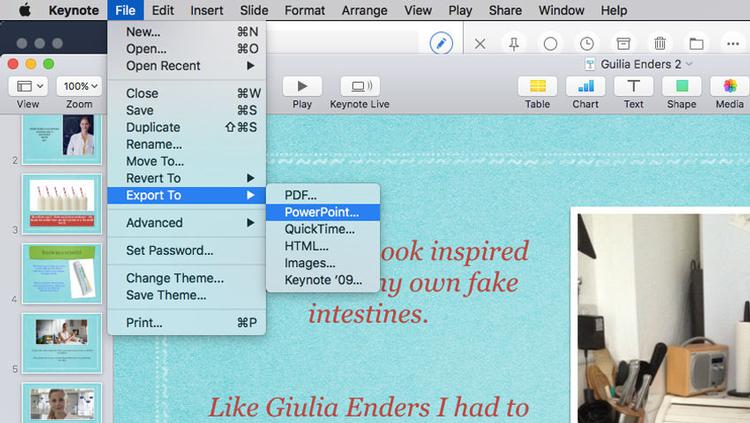
You’ll see a box appear with Format: pptx . This is what you want so click Next , name the file then click Export .

This will create a file that you can now share without fear of getting a ‘how do I open this?’ email.
Use Microsoft Office
Of course the easiest way to interact with PowerPoint files on a Mac is to actually use PowerPoint itself. Microsoft offers the entire Office suite on macOS, and it’s very good.
The current trend is to pay a monthly or yearly fee, the cost of which is £5.99 p/m or £59.99 p/a for a single user licence. Other tiers are also available if you want access to the software on more than one machine.
How to edit a .pptx file on iPad or iPhone
Importing to keynote.
Much like on the Mac, Apple has now made Keynote, Number, Pages, iMovie and GarageBand free on iOS. So if you don’t already have Keynote installed, go to the App Store and download it.
To import your .pptx file you’ll first need to ensure that the file is stored in your iCloud Drive. Once this is done open Keynote, tap Locations in the upper left corner, then select iCloud Drive .
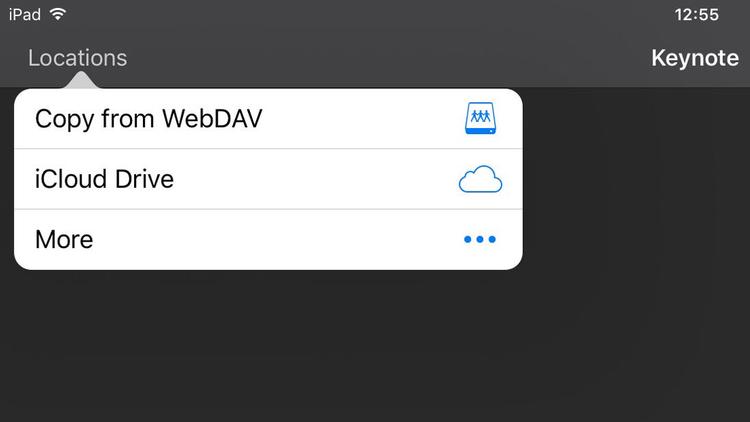
You’ll now be presented with the various folders on iCloud. Navigate to your file and tap it to import it to Keynote.

You might see a dialog box saying you need to change your iCloud settings to allow this. If this happens select Go to Settings and you’ll be taken to the iCloud section. Here you just need to turn the Use iCloud option on.
Once that’s done return to Keynote and repeat the above steps to open your presentation. Again you might see a warning saying that the presentation was created in an older version of the software and that some fonts will be different. Tap Open and you’ll finally see your PowerPoint presentation.
Now you can edit the file, add new slides, effects, and what have you, just like any other Keynote presentation.
Exporting from Keynote
Any presentation you work on in Keynote will automatically be saved as a .key file. When you want to share this with PowerPoint users you’ll first need to convert it to a .pptx file. This is achieved through the Send a Copy feature.
Tap the Presentations option in the top left corner to take you back to the main Keynote menu. Here you’ll see all your files. In the upper right corner is the Share button (a square with a arrow pointing out of the top), tap this.

You’ll be presented with three options – Collaborate with Others , Send a Copy , and Move to… – from which you should choose Send a Copy .
You’ll now be asked to select which file you want to send. Tap your presentation and you’ll see a pop-up box with the file types available. Tap PowerPoint and Keynote will convert your file.

Of course you’ll want to send it to someone, so Keynote will open the Share menu where you can pick which method of communication you wish to use: Mail, Message, WebDav, and a number of others.
Use Microsoft Office Apps
Yep, just like on the Mac you can also use Microsoft’s official PowerPoint app on iPhone and iPad. You can do basic editing on the free version and save to OneDrive, but for full features you’ll need a paid Office365 account.
So there you go, various ways to share and edit PowerPoint files on your Mac, iPhone or iPad. For similar tips be sure to check out our How to open .docx files on Mac, iPhone, and iPad .
Author: Martyn Casserly , Contributor

Martyn has been involved with tech ever since the arrival of his ZX Spectrum back in the early 80s. He covers iOS, Android, Windows and macOS, writing tutorials, buying guides and reviews.
Recent stories by Martyn Casserly:
- iOS 18 vs iOS 17: What’s different with the latest iPhone update?
- iOS versions: Every version of iOS from the oldest to the newest
- iOS compatibility: Find out the latest version your iPhone can run
Unsupported browser
This site was designed for modern browsers and tested with Internet Explorer version 10 and later.
It may not look or work correctly on your browser.
- Presentations
Preparing Your Mac for a Presentation
- Bahasa Indonesia
The days of needing Windows to run an effective presentation are over. With great tools and accessories for running multiple displays — even when one of those displays is a projector — OS X is a great option for your next presentation.
In this tutorial, I will show you how to execute the perfect presentation by preparing your Mac beforehand, choosing the right way to hook up your second display or projecter and ensure nothing will get in the way when things get underway.
Download Our eBook on Making Great Presentations (Free)
We also have the perfect compliment to this tutorial. Quickly grab it before you read on. Download our FREE eBook: The Complete Guide to Making Great Presentations , which will help you write, design, and deliver the perfect presentation.

Choosing a Connection
When you're hosting a presentation with your Mac, there's a strong chance you're going to be opting to use an external display or projector to do so, which means you're going to need a way of hooking your machine up. There's two basic options to do so: wireless, through a system like AirPlay, or using a traditional physical cable.
AirPlay is Apple's protocol for streaming wireless content, introduced in 2010 alongside a new model of Apple TV. AirPlay allows you to stream, to a compatible device, content like music, movies, TV shows and, since 2010, your entire display.
AirPlay Mirroring allows you to mirror your Mac's display on another screen, or projector, that's connected to an AirPlay-compatible device, such as a second or third-generation Apple TV. By choosing to extend your screen, rather than mirror it, you can take full advantage of second-display features such as Presenter View in Keynote, just as if you were using a physical connection.

To set up AirPlay Mirroring, first make sure that both your Mac and the Apple TV (or third-party receiver that supports screen mirroring ) are connected to the same wireless network. Then, open the System Preferences app and choose Displays . At the bottom of this pane, check the box marked Show mirroring options in the menu bar.
If more than one option is available under the Connect To AirPlay Display label, select the device that is connected to the display or project that you want to show your presentation on.

Next, click on the AirPlay icon in your menu bar and choose your preferred option under the Use AirPlay Display To label. Selecting Extend Desktop is recommended, as this will enable second-screen views like Keynote's Presenter View while still showing your presentation as normal on the external display or projector.
When you begin your presentation, it should automatically begin on your newly-connected display.
Cables and Connections
The second option is to use a traditional physical cable to hook up your external display or projector, useful if your presentation is in a location with an unreliable wireless network or if your display doesn't support HDMI, which the Apple TV exclusively uses.

Exactly what cable and/or adapters you need is specific to your setup and differs from venue to venue, display to display. Most displays and projectors will use some form of common display interface such as HDMI or DVI; if your Mac doesn't have a port for this built-in (in which case, you'd simply use a male-to-male cable to hook your Mac up via that port), Apple sells a range of Mini DisplayPort/Thunderbolt adapters . Alternatively, you can choose a compatible adapter from a third-party such as Belkin which may provide a cheaper, yet unofficial, option.
When your Mac is physically tethered to your external display or projector of choice, you can use the Displays pane in your Mac's System Preferences app to modify configurations for resolution and colour. After that, your setup should be good to go and apps like Keynote will automatically use your connected display for your presentation, providing modes like Presenter View on your primary screen.
Do Not Disturb
During most presentations, you're not going to want notifications, alerts and calls to interrupt. OS X has a built-in feature called Do Not Disturb which allows you to toggle notifications on or off universally.
Under most circumstances, you can open Notification Center (by using your configure gesture or by clicking the right-most icon in your Mac's menu bar), scroll up and use the toggle to enable or display Do Not Disturb.
This somewhat hidden feature, introduced with Mountain Lion, hides alerts and banners when turned on. Though manually toggling Do Not Disturb on is an option, you can also automate this process to certain times or, in our case, when you're likely hosting a presentation. First, open System Preferences and then click Notifications . Then, in the Do Not Disturb tab, check the When mirroring to TVs and projectors box. This option will automatically turn Do Not Disturb on when you're mirroring your desktop to an external display or projector, including when you're doing so to run a presentation.

There's a few additional options you can modify here, depending on your specific presentation needs. If you're planning to use FaceTime as part of your presentation, you can check the Allow FaceTime calls from box and choose Favorites from the dropdown field to still allow your favorite contacts to call when Do Not Disturb is active.
Make Great Presentations (Free eBook Download)
We have a helfpul compliment to this tutorial, which will walk you through the complete presentation process. Learn how to write your presentation, design it like a pro, and prepare it to present powerfully.
Download our new eBook: The Complete Guide to Making Great Presentations . It's available for free with a subscription to the Tuts+ Business Newsletter.

The once-accurate adage that Macs aren't useful for work is no longer true. When hosting presentations, your Mac has all a wealthy library of available tools, accessories and applications to help it all run smoothly.
This tutorial has shown you how to get set up your Mac for a presentation, connecting it to your external display and ensuring nothing interrupts the main attraction; now all that's left to do is actually present!

Presentify - Screen Annotation 4+
Screen draw. highlight mouse..
- 4.2 • 81 Ratings
- Offers In-App Purchases
Screenshots
Description.
The best screen annotation app recommended and used by Harvard and MIT professors. Featured by Apple three times. A macOS menu bar app that helps you give better presentations, online classes, or video tutorials by letting you annotate any screen, highlight your cursor, and more. You can annotate anything on the screen, be it images, videos, pdfs, code, you name it. Presentify is quite helpful for online teaching, recording video tutorials, giving a demo, working remotely, and the list goes on. FEATURES ======== ANNOTATION - You can draw on or annotate any screen you wish. Select `Annotate Screen` from the menu bar and start doodling. - A lot of drawing shapes to choose from. You can even write Text now. - Draw with random gradient colors instead of just plain colors. - Auto-erase your annotations. Perfect for emphasizing something specific or explaining your thoughts. Also, toggle its behavior by pressing the Control Key. - You can draw even when other applications are running in full-screen mode. Great for live presentations and during video calls when working remotely. - New Interactive Mode: This opens up Presentify in the background letting the user use other apps and allowing them to annotate by pressing and holding the Fn key. - Now users can interact with the underlying apps when annotating (in default mode) with Presentify. Just press and hold the Fn key to do so. You no longer have to toggle Presentify to advance your presentation slides, play/pause videos, etc. - Highlighter feature lets you highlight portions of text without obscuring it. - You get a Straight Line by pressing and holding the Shift Key while Freehand drawing. And, you can fill the Rectangles and Circles with a semi-transparent color by pressing and holding the Option Key. - Works on iPad connected to a Macbook via Sidecar, Astropad, or Duet. - Works with Keynote (even in Presentation mode). - Compatible with all video calling software like Zoom, Google Meet, Skype, etc. - Works with drawing tablets like XP-Pen, Wacom, etc. WHITEBOARD - Draw on a whiteboard (and not over other apps) if you wish. - You can even change the color of your whiteboard to whatever you feel like. ANNOTATE CONTROLS - A handy control panel to switch between different annotate tools and colors. - Move the control panel anywhere on the screen by dragging it. - Completely hide the control panel. UNDO/REDO SUPPORT - Do not have to worry about mistakes while annotating. KEYBOARD SHORTCUTS - You can start annotating the screen, highlighting your cursor, changing pencil colors and shapes, etc. from any app with simple keyboard shortcuts. - Customize the key shortcuts as you like. HIGHLIGHT YOUR MOUSE POINTER - With Presentify you never have to keep moving your cursor to grab the attention of your audience. - Change your cursor highlight color, opacity, size, and more. - You can even choose to highlight only when you move your cursor/mouse. UPCOMING FEATURES ================= ANNOTATION - Ability to cut and move annotations - Spotlight feature - Zoom MOUSE HIGHLIGHT - New mouse highlight designs and animations OTHERS - Change the slides of your presentation from your iPhone - And, many more PRESS ===== Featured by Apple multiple times. Also, on Hacker News, Reddit, Product Hunt, and various other blogs like ifun.de, igeeksblog.com, etc. with more than 230 upvotes in each. CONTACT ======= For any questions or concerns, you can head to presentify.compzets.com and see the faq page or click on the Support link.
Version 4.2.0
ANNOTATE - Two new favorite color options. This makes the total number of favorite colors to five. - You can now choose between two keys for Interactive mode. Choose Fn if you're a fan of press & hold, or Caps Lock if you prefer to press it just once. OTHERS - Minor bug fixed where the key shortcut wasn't getting displayed for Cursor Highlight in the dropdown menu. - Sharp new menubar icon.
Ratings and Reviews
Really close to perfect, just needs more color buttons and keystroke eraser.
This app is the closest answer I've gotten to my perfect annotator prayers. It's clear that the developer has thought this app through carefully and worked hard on it. It's so incredibly functional, fast, and easily accesible. The hotkeys, in particular, are very well thought out and puts other apps to shame. Please, please consider adding the below 2 items to get this app to top-tier level. I'll gladly rate up to 5 stars. 1. Add more color buttons to the tool bar. I use 4 colors on a daily basis and this is sorely needed. 5 would be even better. If toolbar size is a concern, perhaps make it an option to display 3, 4, or 5 color selections at a time. 2. Keystroke eraser with eraser size option (like the [ ] function) is needed so that can erase selected items only.
Really nice screen drawing app; just missing one thing for me
The only thing I find a bit awkward about this app is the Annotate in Interactive Mode key. What I need from this feature is for the key to work like a toggle key, and it would be really nice to be able to bind this key to something else. Currently, the options are fn (which behaves as a tap-and-hold kind of toggle) and caps (which behaves as what I want, a tap toggle). The problem with using caps as the tap toggle is that all my text boxes start showing the capslock is on, and in some cases I get into a state where capslock is stuck on when not annotating.
Pretty good - couple recommendations
Overall, decent app, and am happy I purchased it. With that being said, here's a couple recommendations for the developer to make this a 5-star application: 1. Add the ability to erase under cursor (as opposed to only being able to clear the entire screen or edit undo currently). There are manu scenarios where I want to erase something written down several minutes ago as part of problem solving. 2. When using "Interactive Mode", allow us to configure in the preferences whether we want to "hold" the button down as it is today, or instead use said button as a "toggle" to flip between so that we don't need to hold down the button for the duration. 3. Add thin, medium, thick (customizable) to the toolbar to allow for quick switching between thicknesses (I frequently need to switch between the thinnest for regular writing, and a super fat thickness when using the highlighter mode).
Developer Response ,
Thanks for such a detailed review. I will definitely work on them. However, just fyi, you can change thickness easily by pressing [ and ] keys. Have you tried it? Best, Ram
App Privacy
The developer, Ram Patra , indicated that the app’s privacy practices may include handling of data as described below. For more information, see the developer’s privacy policy .
Data Not Collected
The developer does not collect any data from this app.
Privacy practices may vary, for example, based on the features you use or your age. Learn More
Information
English, German, Russian
- High Five $8.99
- Salute $17.99
- Cheers $3.99
- Developer Website
- App Support
- Privacy Policy
Featured In
More by this developer.
Cluedo Notes

Powerpoint and Macbooks: How to use mirrored Presenter View in a 3 screen setup
Mac + Powerpoint
Using Powerpoint Presenter View for speakers on Corporate Events
When a presenter shows their Powerpoint-presentation from a stage or a studio, they usually want to see the presenter-view while they are talking. Here they can see their slides and presenter-notes.

The presenter-view in Powerpoint for mac.
In corporate events, there are two ways to play the presentation. For smaller events, the presenter can bring their own laptop to the stage and use this to play the presentation. By plugging the laptop straight to the projector, the presenter can see the presenter-view on the internal display, and the actual presentation is shown on the external display.
But for bigger events, the A/V team wants more control of the presentation-computer, so the presentation needs to be played from a computer placed at the Front of House. From there it can feed the projector, the streaming-device, and send the presenter-view to a separate monitor on the stage.
In order to display Presenter View on a separate display using laptops, you normally want to mirror your internal display with the stage monitor. Then both monitors will show the presenter view, and the external display will show the full presentation.

Screen setup when using a laptop placed at FOH to play the presentation. The laptop-display is mirrored with a monitor on the stage, and the projector shows the full presentation
MacBook screen setup for mirrored display
With Macs you can set up the screen-configuration from the Displays settings in System Preferences. (Example below is from Mac OS Ventura)

One of the external displays can mirror the main display.

When you go to “arrange”, the stacked images shows which screens are mirrored.
In Powerpoint, make sure that presenter-view is enabled from the settings. Go to Slide Show from the preferences in the top menu bar.

Go to “Set up slide show” from the Slide Show tab above the edit-window. Select Monitor 2 or Auto as the Slide Show monitor.

You would assume that this would be enough to ensure that the presenter-screen is mirrored and the presentation shown on the external display. But, to our surprise, when we play the presentation, the presenter-view is no longer mirrored on the stage-monitor. Instead, only the desktop is shown:

In PC this works seamlessly. So why doesn’t it work in Mac? And can we solve it? Yes! After years of grey hair and frustration, I think I have finally found a way around this issue:
How to solve the problem – what works for me
- Identify what Powerpoint means by Monitor 2
First you must stop all mirroring on your MacBook. Have your internal display set up as the Main display, and the two connected displays as extended. You will then have 3 separate displays in the display settings

Now go to Powerpoint. In the Slide Show settings, go to Set up slide show. Set the Monitor to Monitor 2, or Automatic. (same as earlier before)

Then play the presentation, and take note of what is the screen where the presentation is displayed. In this example, Monitor 2 from Powerpoint is the stage monitor. This won’t work. (see next step)

2. Make sure that Monitor 2 in Powerpoint is routed to the display where you want to show the presentation
From step 1: If Monitor 2 is the display used to show the presentation to the audience, then you can proceed to step 3. If Monitor 2 is the stage-monitor that you want for presenter-view, then you need to swap the routing of two hdmi-outputs from your Macbook . If you send the hdmi-cables through a hardware switcher, then you can do this internally in the switcher. This would be my preferred way of action as it doesn’t involve any physical unplugging and patching. Also, the Macbook wouldn’t be aware of these changes, so you won’t change any internal mac-settings.

Routing the HDMI-outputs from the Macbook throug video switcher. Pictured is Roland v-1hd

After swapping HDMI cables from the MacBook, we change what is defined as Monitor 2 in Powerpoint
3. Turn on Mirrored screen
Now you can turn the mirror back on, with the stage monitor mirroring the internal display on the mac

We have identified that DAC70 is the stage-monitor, and we set that as mirrored display.
4. Check that the Monitor in Powerpoint is set to Automatic or Monitor 2

Now you are good to go: If you play the presentation, you will get the configuration with presenter view on the stage-monitor

Hurra, it finally works!
Equipment used for testing
To reach the conlusions above, I have tested with these Macs: – 15″ Macbook Pro 2015 – 14″ Macbook Pro 2021 – 15″ MacBook Pro 2018. OS: Monterey. Powerpoint-version: 16
Using this method with APS
Auto Presentation Switcher , gives you more ways to open, display and switch presentations. When opening presentations on Mac with APS, the monitor where the presentation is shown is taken from the Powerpoint settings. So you don’t need any additional preparation to use this method with APS.
Update 5. October 2022:
Since I wrote this text I have used the 3-screen Powerpoint Mac setup on several events. It hasn’t failed me so far. I feel more confident now than before that this article describes how you can use the 3 screen setup with Powerpoint for Mac. However, there is no guarantee that this solution will work for every Mac that has 3 screen outputs. It would be very interesting if more people could test this method, and share how it works for them.
Written by Morten Brekke Stensland
Subscribe to our Newsletter
Be the first to know about the latest news from PresentationTools
Contact & Follow

Company Invoicing
© PresentationTools A/S 2024
keynote not printing a handout of my presentation - help please
I am using Keynote 12.1 and can't get the printer to show "choose Keynote" in order to print a handout of my presentations. ( I used to do this in MS Powerpoint and it was quite easy.)
MacBook Pro 13″, macOS 10.13
Posted on Jun 22, 2024 1:47 PM
Loading page content
Page content loaded
There are no replies.
Introducing Apple Intelligence, the personal intelligence system that puts powerful generative models at the core of iPhone, iPad, and Mac
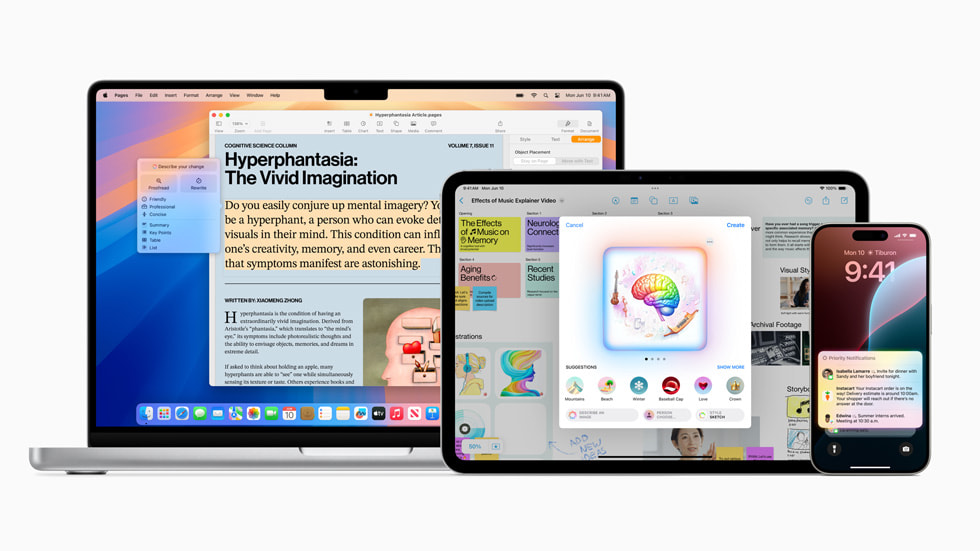
New Capabilities for Understanding and Creating Language
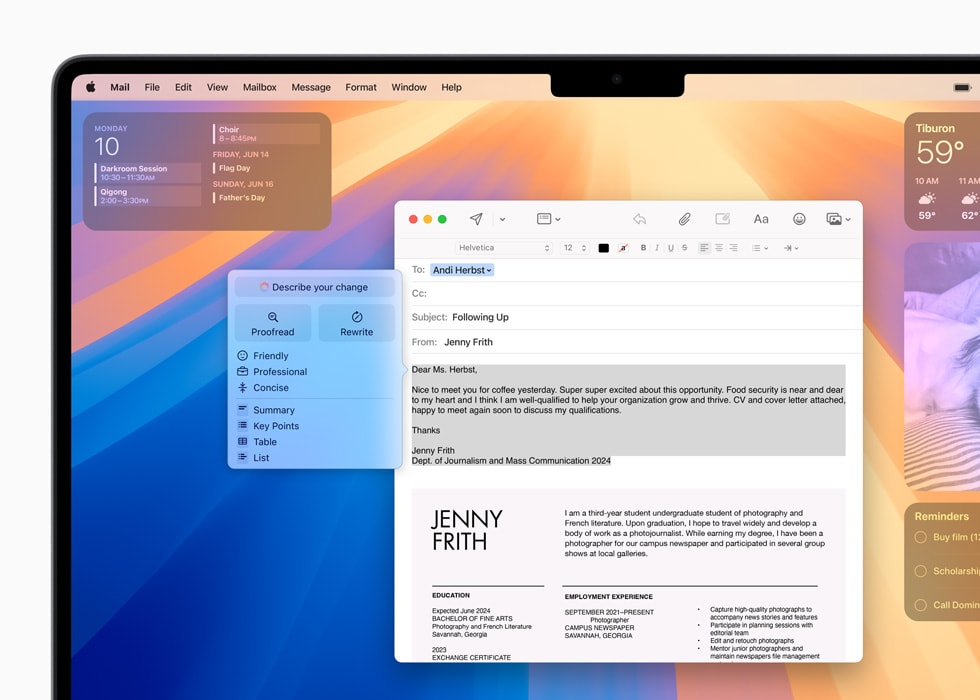
Image Playground Makes Communication and Self‑Expression Even More Fun
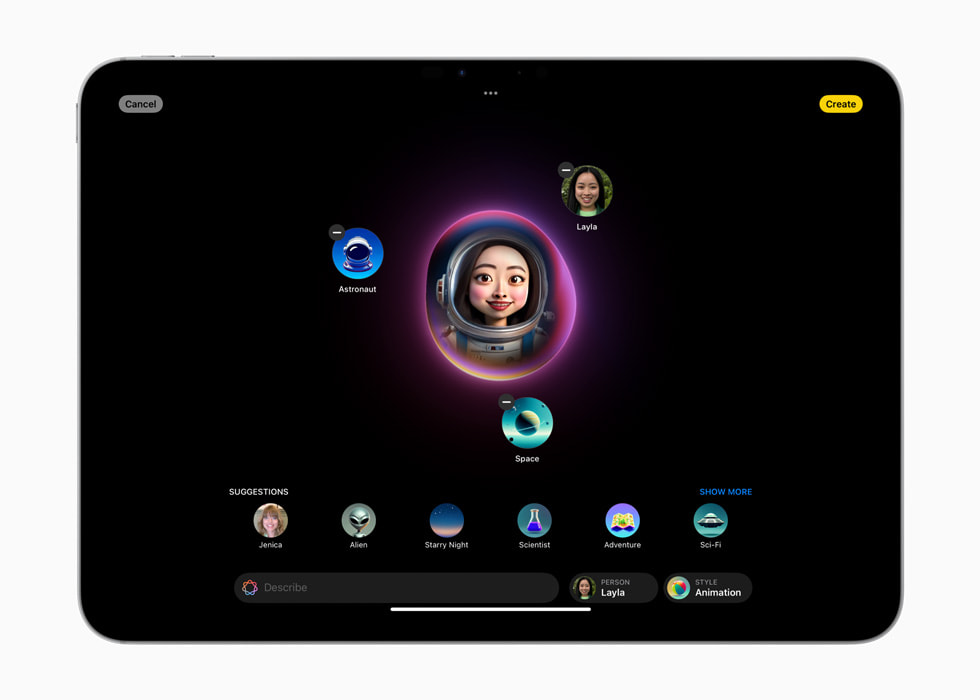
Genmoji Creation to Fit Any Moment
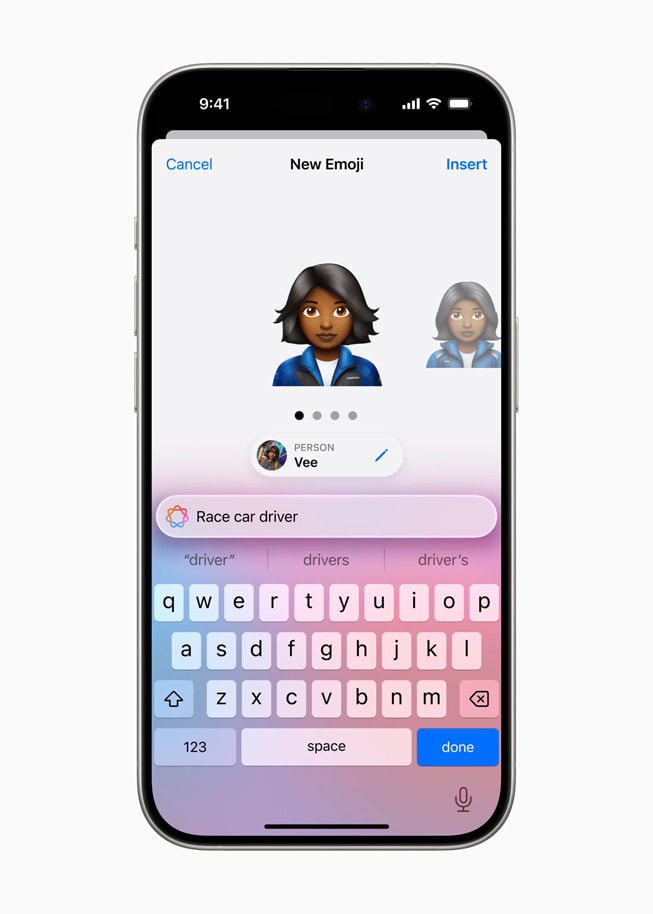
New Features in Photos Give Users More Control
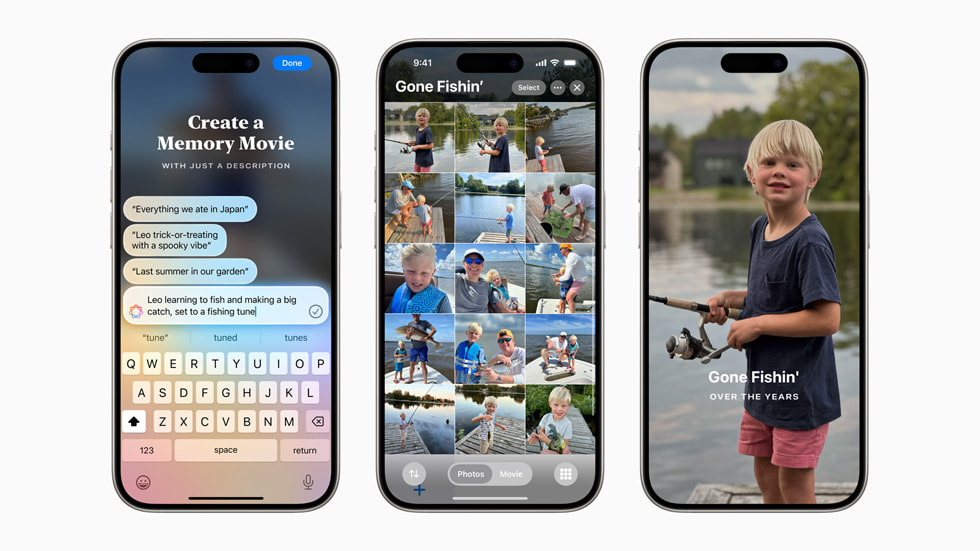
Siri Enters a New Era

A New Standard for Privacy in AI
ChatGPT Gets Integrated Across Apple Platforms
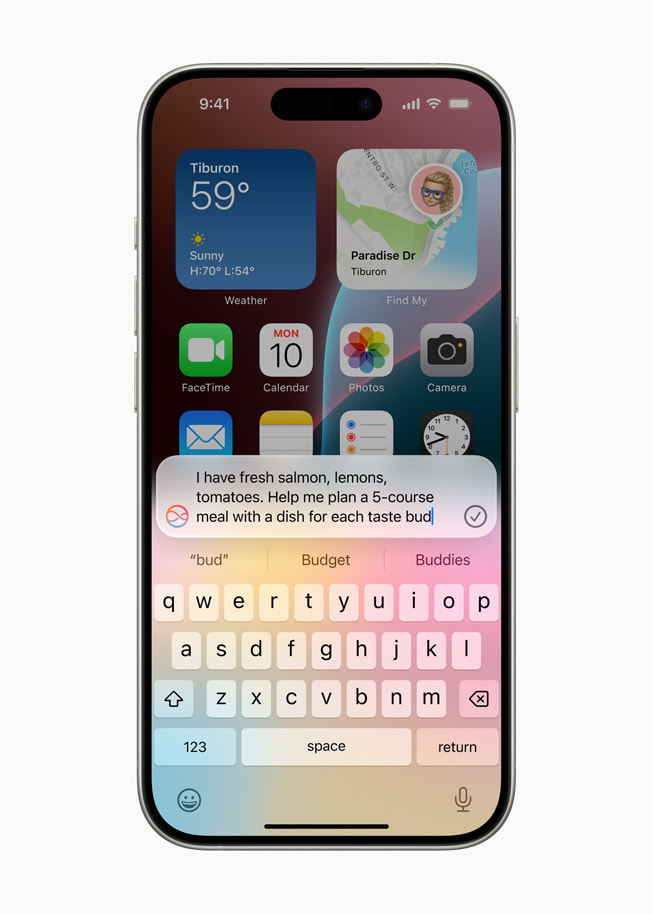
Text of this article
June 10, 2024
PRESS RELEASE
Setting a new standard for privacy in AI, Apple Intelligence understands personal context to deliver intelligence that is helpful and relevant
CUPERTINO, CALIFORNIA Apple today introduced Apple Intelligence , the personal intelligence system for iPhone, iPad, and Mac that combines the power of generative models with personal context to deliver intelligence that’s incredibly useful and relevant. Apple Intelligence is deeply integrated into iOS 18, iPadOS 18, and macOS Sequoia. It harnesses the power of Apple silicon to understand and create language and images, take action across apps, and draw from personal context to simplify and accelerate everyday tasks. With Private Cloud Compute, Apple sets a new standard for privacy in AI, with the ability to flex and scale computational capacity between on-device processing and larger, server-based models that run on dedicated Apple silicon servers.
“We’re thrilled to introduce a new chapter in Apple innovation. Apple Intelligence will transform what users can do with our products — and what our products can do for our users,” said Tim Cook, Apple’s CEO. “Our unique approach combines generative AI with a user’s personal context to deliver truly helpful intelligence. And it can access that information in a completely private and secure way to help users do the things that matter most to them. This is AI as only Apple can deliver it, and we can’t wait for users to experience what it can do.”
Apple Intelligence unlocks new ways for users to enhance their writing and communicate more effectively. With brand-new systemwide Writing Tools built into iOS 18, iPadOS 18, and macOS Sequoia, users can rewrite, proofread, and summarize text nearly everywhere they write, including Mail, Notes, Pages, and third-party apps.
Whether tidying up class notes, ensuring a blog post reads just right, or making sure an email is perfectly crafted, Writing Tools help users feel more confident in their writing. With Rewrite, Apple Intelligence allows users to choose from different versions of what they have written, adjusting the tone to suit the audience and task at hand. From finessing a cover letter, to adding humor and creativity to a party invitation, Rewrite helps deliver the right words to meet the occasion. Proofread checks grammar, word choice, and sentence structure while also suggesting edits — along with explanations of the edits — that users can review or quickly accept. With Summarize, users can select text and have it recapped in the form of a digestible paragraph, bulleted key points, a table, or a list.
In Mail, staying on top of emails has never been easier. With Priority Messages, a new section at the top of the inbox shows the most urgent emails, like a same-day dinner invitation or boarding pass. Across a user’s inbox, instead of previewing the first few lines of each email, they can see summaries without needing to open a message. For long threads, users can view pertinent details with just a tap. Smart Reply provides suggestions for a quick response, and will identify questions in an email to ensure everything is answered.
Deep understanding of language also extends to Notifications. Priority Notifications appear at the top of the stack to surface what’s most important, and summaries help users scan long or stacked notifications to show key details right on the Lock Screen, such as when a group chat is particularly active. And to help users stay present in what they’re doing, Reduce Interruptions is a new Focus that surfaces only the notifications that might need immediate attention, like a text about an early pickup from daycare.
In the Notes and Phone apps, users can now record, transcribe, and summarize audio. When a recording is initiated while on a call, participants are automatically notified, and once the call ends, Apple Intelligence generates a summary to help recall key points.
Apple Intelligence powers exciting image creation capabilities to help users communicate and express themselves in new ways. With Image Playground, users can create fun images in seconds, choosing from three styles: Animation, Illustration, or Sketch. Image Playground is easy to use and built right into apps including Messages. It’s also available in a dedicated app, perfect for experimenting with different concepts and styles. All images are created on device, giving users the freedom to experiment with as many images as they want.
With Image Playground, users can choose from a range of concepts from categories like themes, costumes, accessories, and places; type a description to define an image; choose someone from their personal photo library to include in their image; and pick their favorite style.
With the Image Playground experience in Messages, users can quickly create fun images for their friends, and even see personalized suggested concepts related to their conversations. For example, if a user is messaging a group about going hiking, they’ll see suggested concepts related to their friends, their destination, and their activity, making image creation even faster and more relevant.
In Notes, users can access Image Playground through the new Image Wand in the Apple Pencil tool palette, making notes more visually engaging. Rough sketches can be turned into delightful images, and users can even select empty space to create an image using context from the surrounding area. Image Playground is also available in apps like Keynote, Freeform, and Pages, as well as in third-party apps that adopt the new Image Playground API.
Taking emoji to an entirely new level, users can create an original Genmoji to express themselves. By simply typing a description, their Genmoji appears, along with additional options. Users can even create Genmoji of friends and family based on their photos. Just like emoji, Genmoji can be added inline to messages, or shared as a sticker or reaction in a Tapback.
Searching for photos and videos becomes even more convenient with Apple Intelligence. Natural language can be used to search for specific photos, such as “Maya skateboarding in a tie-dye shirt,” or “Katie with stickers on her face.” Search in videos also becomes more powerful with the ability to find specific moments in clips so users can go right to the relevant segment. Additionally, the new Clean Up tool can identify and remove distracting objects in the background of a photo — without accidentally altering the subject.
With Memories, users can create the story they want to see by simply typing a description. Using language and image understanding, Apple Intelligence will pick out the best photos and videos based on the description, craft a storyline with chapters based on themes identified from the photos, and arrange them into a movie with its own narrative arc. Users will even get song suggestions to match their memory from Apple Music. As with all Apple Intelligence features, user photos and videos are kept private on device and are not shared with Apple or anyone else.
Powered by Apple Intelligence, Siri becomes more deeply integrated into the system experience. With richer language-understanding capabilities, Siri is more natural, more contextually relevant, and more personal, with the ability to simplify and accelerate everyday tasks. It can follow along if users stumble over words and maintain context from one request to the next. Additionally, users can type to Siri, and switch between text and voice to communicate with Siri in whatever way feels right for the moment. Siri also has a brand-new design with an elegant glowing light that wraps around the edge of the screen when Siri is active.
Siri can now give users device support everywhere they go, and answer thousands of questions about how to do something on iPhone, iPad, and Mac. Users can learn everything from how to schedule an email in the Mail app, to how to switch from Light to Dark Mode.
With onscreen awareness, Siri will be able to understand and take action with users’ content in more apps over time. For example, if a friend texts a user their new address in Messages, the receiver can say, “Add this address to his contact card.”
With Apple Intelligence, Siri will be able to take hundreds of new actions in and across Apple and third-party apps. For example, a user could say, “Bring up that article about cicadas from my Reading List,” or “Send the photos from the barbecue on Saturday to Malia,” and Siri will take care of it.
Siri will be able to deliver intelligence that’s tailored to the user and their on-device information. For example, a user can say, “Play that podcast that Jamie recommended,” and Siri will locate and play the episode, without the user having to remember whether it was mentioned in a text or an email. Or they could ask, “When is Mom’s flight landing?” and Siri will find the flight details and cross-reference them with real-time flight tracking to give an arrival time.
To be truly helpful, Apple Intelligence relies on understanding deep personal context while also protecting user privacy. A cornerstone of Apple Intelligence is on-device processing, and many of the models that power it run entirely on device. To run more complex requests that require more processing power, Private Cloud Compute extends the privacy and security of Apple devices into the cloud to unlock even more intelligence.
With Private Cloud Compute, Apple Intelligence can flex and scale its computational capacity and draw on larger, server-based models for more complex requests. These models run on servers powered by Apple silicon, providing a foundation that allows Apple to ensure that data is never retained or exposed.
Independent experts can inspect the code that runs on Apple silicon servers to verify privacy, and Private Cloud Compute cryptographically ensures that iPhone, iPad, and Mac do not talk to a server unless its software has been publicly logged for inspection. Apple Intelligence with Private Cloud Compute sets a new standard for privacy in AI, unlocking intelligence users can trust.
Apple is integrating ChatGPT access into experiences within iOS 18, iPadOS 18, and macOS Sequoia, allowing users to access its expertise — as well as its image- and document-understanding capabilities — without needing to jump between tools.
Siri can tap into ChatGPT’s expertise when helpful. Users are asked before any questions are sent to ChatGPT, along with any documents or photos, and Siri then presents the answer directly.
Additionally, ChatGPT will be available in Apple’s systemwide Writing Tools, which help users generate content for anything they are writing about. With Compose, users can also access ChatGPT image tools to generate images in a wide variety of styles to complement what they are writing.
Privacy protections are built in for users who access ChatGPT — their IP addresses are obscured, and OpenAI won’t store requests. ChatGPT’s data-use policies apply for users who choose to connect their account.
ChatGPT will come to iOS 18, iPadOS 18, and macOS Sequoia later this year, powered by GPT-4o. Users can access it for free without creating an account, and ChatGPT subscribers can connect their accounts and access paid features right from these experiences.
Availability
Apple Intelligence is free for users, and will be available in beta as part of iOS 18 , iPadOS 18 , and macOS Sequoia this fall in U.S. English. Some features, software platforms, and additional languages will come over the course of the next year. Apple Intelligence will be available on iPhone 15 Pro, iPhone 15 Pro Max, and iPad and Mac with M1 and later, with Siri and device language set to U.S. English. For more information, visit apple.com/apple-intelligence .
Press Contacts
Cat Franklin
Jacqueline Roy
Apple Media Helpline
Images in this article
- English Español Deutsch Português Italiano Français 日本語 한국어 繁體中文 Türkçe Dutch Polish Thai Indonesian Malay
- Free Download For Windows For macOS
- Screen Recording RecExperts For Windows Screen recorder for PC RecExperts For Mac Screen recorder for macOS Online Screen Recorder Record screen online free ScreenShot Take Screenshot on PC
- Buy Now Buy Now
- Student Discount
- Resources Screen Recorder Windows 10 Record Zoom Meeting Record Internal Audio Mac Record Gameplay on PC Video Recording Software
- Support Support Center Guides, License, Contact Chat Support Chat with a Technician Pre-Sales Inquiry Chat with a Sales Rep
How to Record a Presentation with Your Face (Audio and Video)
How to record a presentation with your face? This article offers three ways: video record all presentations without limits by using EaseUS RecExperts, record a PowerPoint presentation with its default recording function, and record Google slideshows via its built-in recorder.
Trustpilot Rating 4.7
Don’t forget to share this post!
Page Table of Contents
Updated on Jun 19, 2024
The development of technology enriches communication forms. From professors to business consultants, college to company, and school assignments to work reports, self-presenting has become indispensable in our study and work.
Adding narration in Google Slides, meetings, and other scenarios not only enhances audience engagement but also conveys ideas efficiently. So, users are more inclined to record presentations with their faces and audio.
This guide will teach you how to record a presentation with your face in PowerPoint, Google Slides, and other video narration forms. Read this article and get free video recording software to record slide about yourself easily and effectively.
|
|
|
|
| 🔥 | - No time limit; no license or signup; no lag or watermark |
|
| ⭐ | - Need a Microsoft Office license; recordings saved on each slide separately; record the PPT area only; saved video file size super large |
|
| 👍 | - Need a Google account; recording length up to 30 minutes; affected by the Google Drive storage |
|
How to Record Presentation with Face Using EaseUS RecExperts
A professional screen recorder like EaseUS RecExperts would be the best way to record PPT with video. It helps you record yourself presenting a PowerPoint , including your face and audio.
Narrators can record PowerPoint with webcam and audio, easily record presentations on Google Slides, and effectively record a presentation on Zoom with face. This easy-to-use presentation recorder can simplify the experience of recording presentations with faces.
EaseUS RecExperts
- Record Google Slides , MS PowerPoint, Zoom meetings, and other presentations with face, audio, and video using a webcam and microphone.
- Record about me presentation, self-presenting videos, and slide about yourself without time limit, lag, or watermark.
- Record full screen , part of screen, and any region of screen on computer.
- Save a PowerPoint as a video in high-quality. The AI-empowered function can reduce noise naturally.
Now, let's see how to record a presentation with your face.
Step 1. Launch EaseUS RecExperts on your computer. Choose a recording mode from "Full Screen" or "Region" . To record a part of the screen, select the recording area manually.
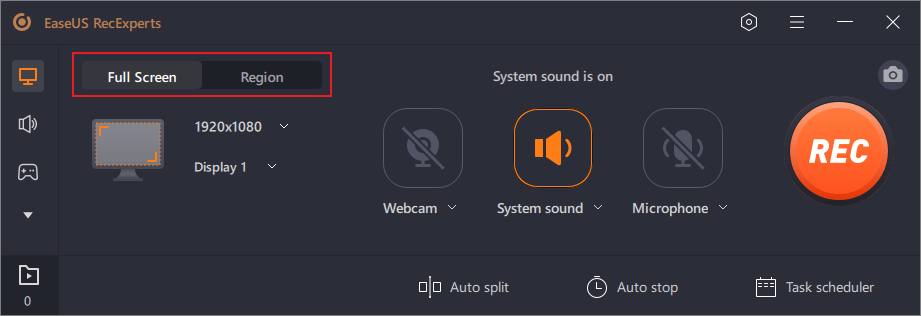
Step 2. After selecting the recording mode, click on the camera sign on the interface. This will let the tool record your screen and the webcam at the same time.
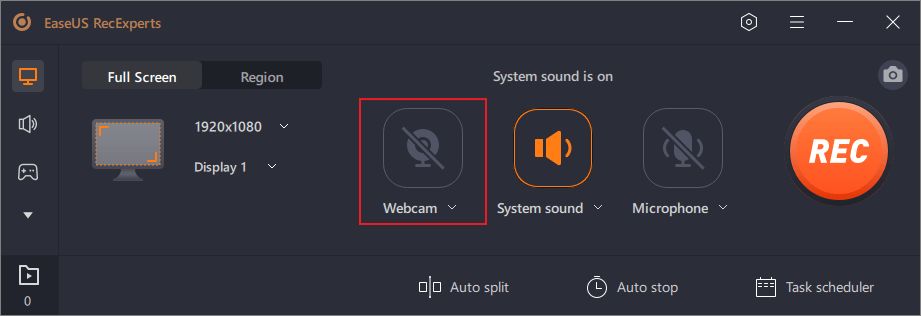
Step 3. You can also change the background with the AI Recognition ot green screen feature. Classroom, blur, studio, or your local images are supported. Just click "Webcam" > "Settings" > "Remove Background" to download and use these modules. Then, click the "REC" button to start recording.
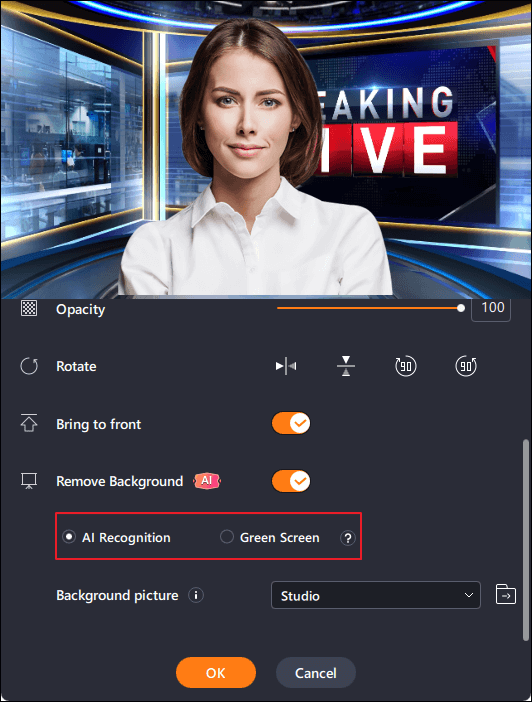
Step 4. After recording, the recording list window will open. Here you can view, split, delete, manage your recordings easily.
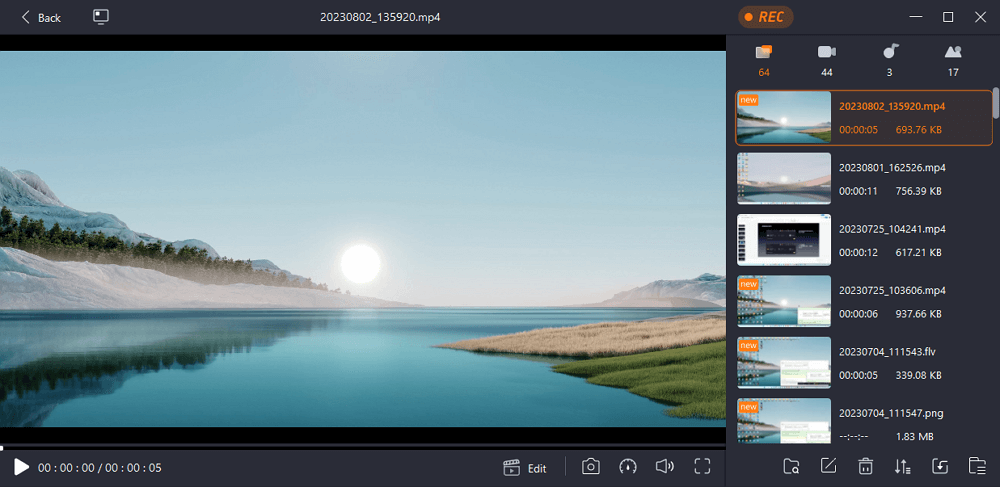
How to Record a PowerPoint Presentation with Your Face via the Internal Recorder
If you want to record yourself talking in Microsoft PowerPoint, an inbuilt screen recorder is provided. You can record PowerPoint presentations with audio and video through its Record Slide Show or Screen Recording feature.
Before learning how to record on PowerPoint, pay attention to the following tips:
➤ You need to have a license for Microsoft Office to use PowerPoint.
➤ Check if the webcam and microphone are pre-placed well before recording.
➤ A new recording is saved on each slide separately. So, you should cover everything on one slide and not go back, otherwise the new recording will replace the previous one.
➤ Microsoft PowerPoint only records the PPT area, not supporting full-screen recording.
➤ The saved videos are very large. Make sure your computer has enough space.
After reading the perquisites, let's see how to record a PowerPoint presentation with your face.
Step 1. On the toolbar, tap Record Slide Show or Screen Recording .

Step 2. Click Record . Then, you can select Record from Current Slide… or Record from Beginning… .
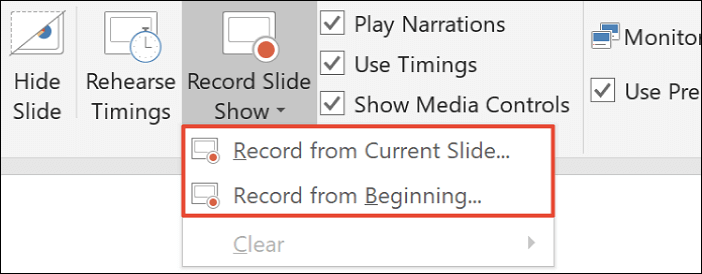
Step 3. You have entered the recording screen. In the bottom right corner, turn on the microphone and webcam.
Step 4. Click Record in the upper left corner. It starts recording the PPT on yourself with audio. Click the arrow to move to the next slide, and use the pen to write notes on the slide if needed.

Step 5. To stop recording in PPT, click Stop .
Step 6. To save a PowerPoint as a video, go to Files > Export > Create a Video in the upper left corner. The recording file will be saved in MP4 format.
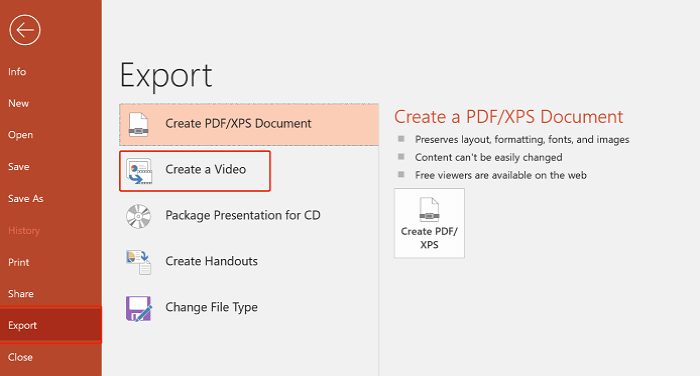
Share this post on your social platform to help more people!
How to Record a Presentation with Your Face Google Slides via the Default Recorder
Google Slides is another popular presentation tool that allows users to record video with face. Unlike MS, Google Slides is a cloud-based software that requires no installation or license. But there are some limitations you need to pay attention to:
➤ Each presentation can be recorded for up to 30 minutes.
➤ You need a Google account to use this function.
➤ There is a storage limit. You cannot record new videos if the Google Cloud has insufficient space.
After reading the perquisites, let's see how to record a presentation with your face Google Slides:
Step 1. Open a browser, sign into your Google account, and visit Google Slides .
Step 2. Create or open a PPT, click the Rec button in the upper right corner, and tap Record new video .
Step 3. You will enter the screen recording interface. Press the red button to start recording.
Step 4. In the coming prompt, click Allow and toggle on Also allow tab audio to enable the camera and microphone. Now, you can record your face and voice.
Step 5. To end the recording, press the red button again. Here, you can click Re-record to start over or click Save to Drive to save the presentation as a video.
Extra Tip: How to Record a PowerPoint Presentation with Your Face on Mac
Since there is not a Mac version of MS PowerPoint, users may ask what is the best way to record a presentation for Mac ?
For how to record a PowerPoint presentation with your face Mac, you have two options:
Way 1. Use the Mac built-in recorder - QuickTime Player
Although Mac has a default presentation recorder, it cannot capture internal sound. If you want to record screen on Mac with audio , you need to download and install an extra add-on extension: Soundflower.
Step 1. Open the Soundflower download page . Then, download and install Soundflower on your Mac.
Step 2. Launch Soundflower and go to System Preferences > Volume . Click the Gear icon at the bottom-left panel. Tap Create a Mult-Output Device > Built-in Output > Soundflower (2ch) .
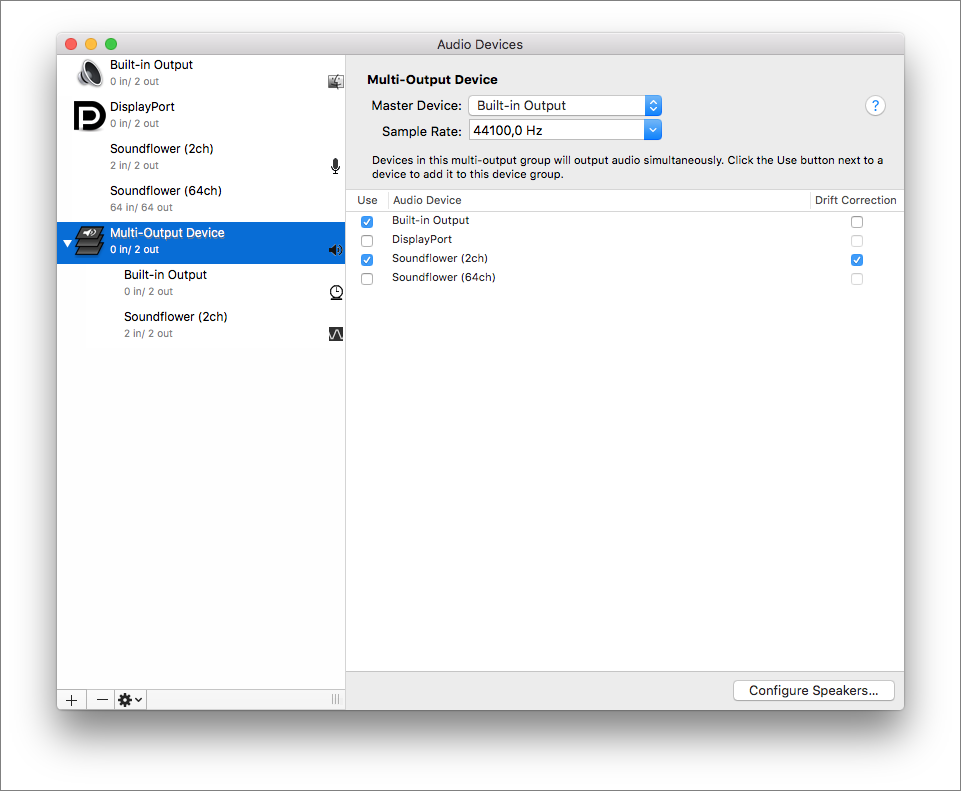
Step 3. Click the Gear button again and click Use This Device for Sound Output .
Step 4. Open QuickTime Player, navigate to File > New Screen Recording , tap the down-arrow icon next to the record button, and choose Soundflower (2ch) as the microphone device.
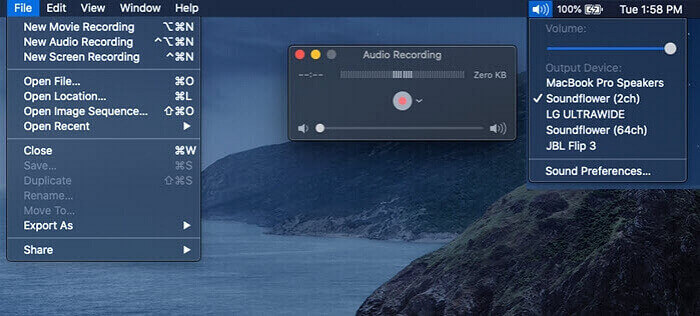
Step 5. Now, open the presentation PPT and locate the slide you want to record.
Step 6. Click Record to start recording slide about yourself.
Step 7. To stop recording in PPT, the Stop button.
Way 2. Try another presentation recorder - EaseUS RecExperts for Mac
To record presentation with face and audio directly, you can use a Mac screen recorder . Compared with QuickTime Player, it offers an easier and more straightforward solution.

Step 1. Firstly, launch EaseUS RecExperts on your Mac. There are two options, "Full Screen" and "Region," for you to select the recording area.
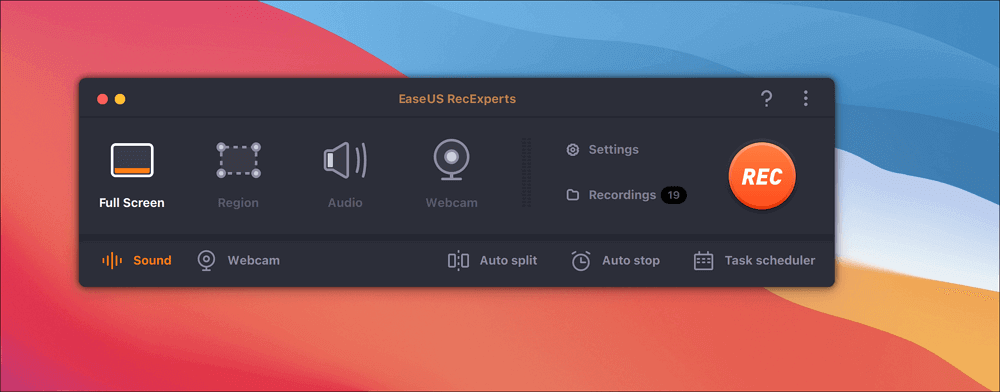
Step 2. Then, click on the "Webcam" button at the bottom. When a "Record webcam" window pops up, click the button to activate the webcam, and you can select the device you want to use from the dropdown menu.
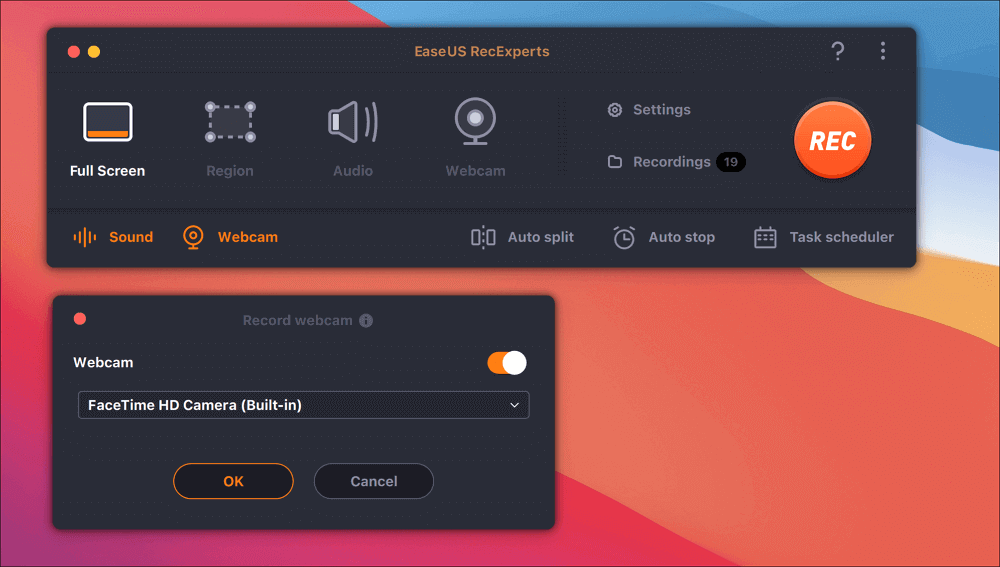
Step 3. If you want to capture the screen with audio, the "Sound" button beside "Webcam" can help. You can click on the two buttons on the "Select recording sound" window to choose the audio source, such as the system sound, the microphone audio, or two of them.
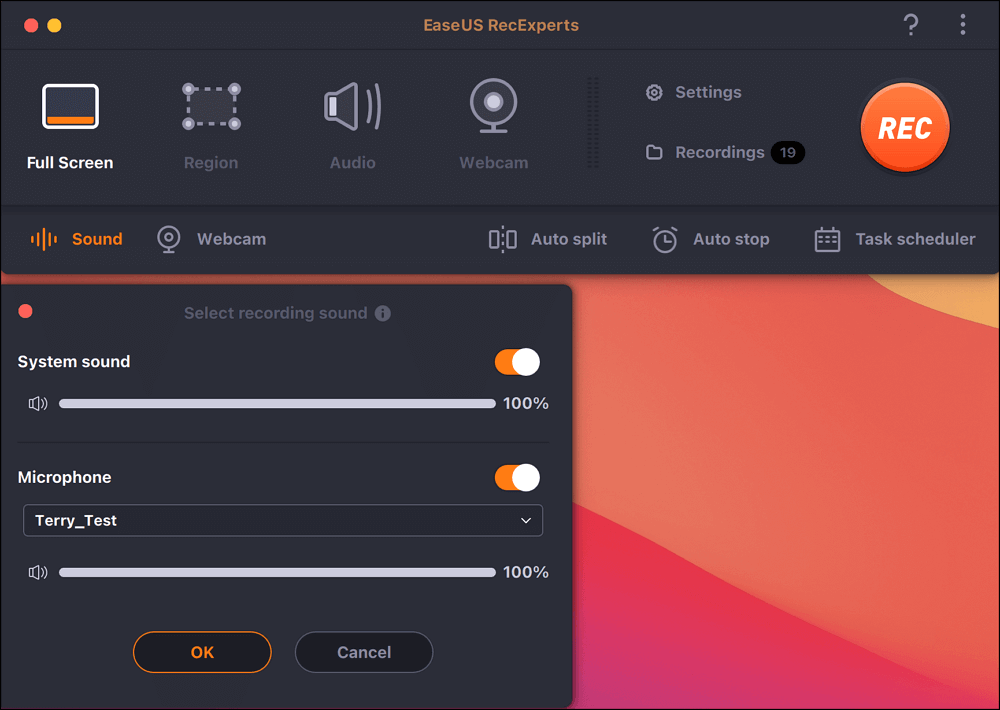
After adjusting the settings appropriately, click on the "REC" button to start recording.
Step 4. Now, you can record the Mac screen and your webcam at the same time. After capturing all the content you need, hit the "Stop" button to end it, and this software will offer you a built-in video player to view the video you captured.

Guess now you have known how to record a presentation with your face . To summarize, both the internal recording functions in PowerPoint and Google Slides are limited. If you want to record PowerPoint, Google Slides, Zoom, or other presentations without any limits, use EaseUS RecExperts.
It allows narrators to record their PPT with face easily. No time limit, no screen size limit, and no sophisticated steps. Download this free presentation recorder to your computer and give it a shot.
FAQs on How to Record a Presentation with Your Face
Learn more frequently asked questions on how to record presentation with face.
1. Is there a free recording app?
Yes, there is a free recording app called EaseUS RecExperts. This versatile screen recorder lets you record everything you want, including presentation, video conference, streaming video, gameplay, YouTube, and more. You can record full screen or part of screen to your liking.
2. Why can't I record my face on PowerPoint?
Recording face on PowerPoint not working can be caused by:
- The microphone not enabled. Go to Settings on PowerPoint to check if you give access to your microphone.
- Insufficient disk space. You need to free up your drive and leave more storage space.
3. How do you present yourself in PowerPoint?
To present yourself in PowerPoint, you can use the built-in recorder in MS PowerPoint. Here are the steps:
Step 1. Go to Record Slide Show or Screen Recording .
Step 2. Click Record > Record from Current Slide… or Record from Beginning… .
Step 3. Click Record on the upper left corner to video record yourself presenting a PowerPoint.
Step 4. Click Stop to end recording the introduction slide about yourself.

One-click to capture anything on screen!
No Time Limit, No watermark
Melissa Lee
Related Posts

How to Record Overwatch with 4 Ways

Top 10 Best Video Player for Windows 11 [2024 Updated]
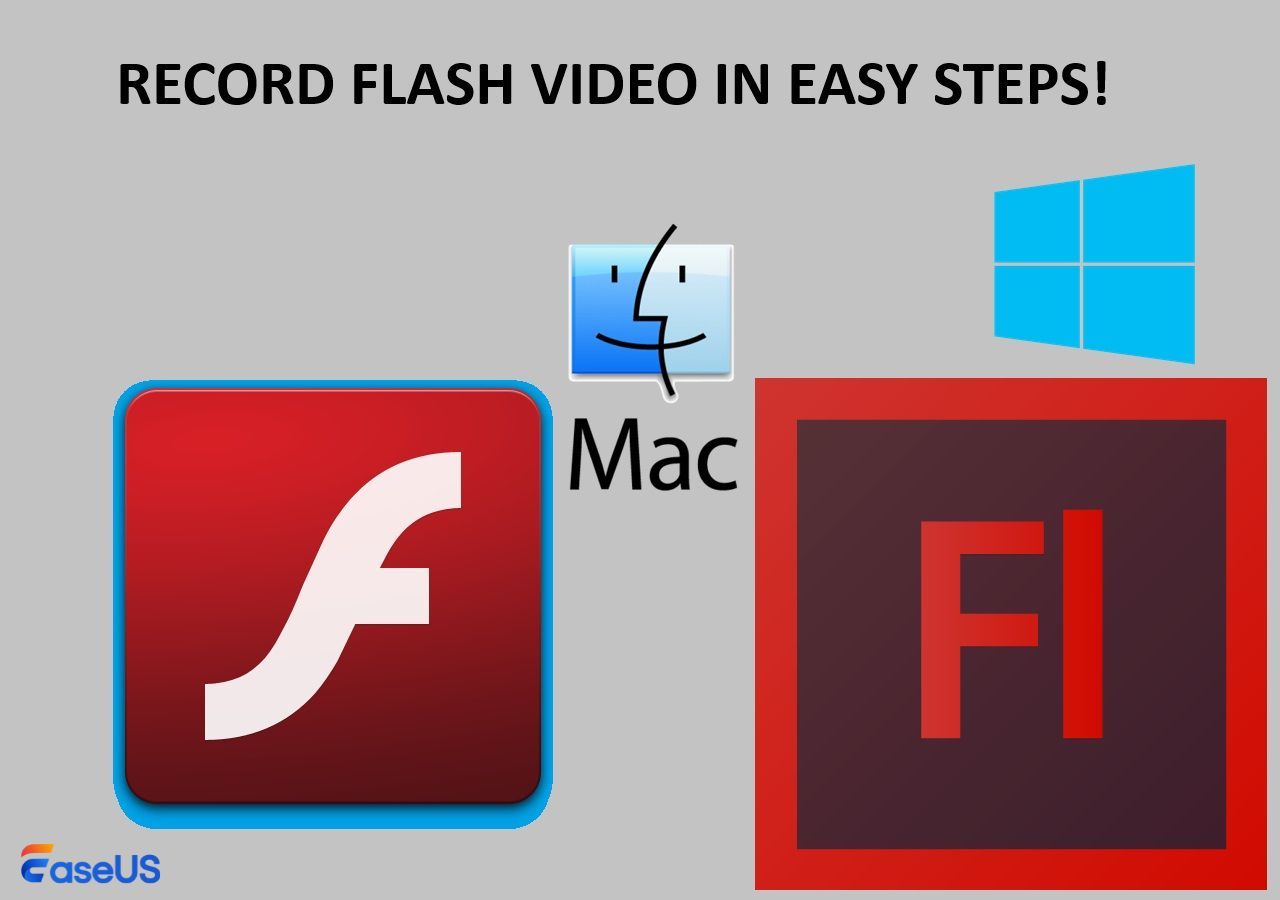
How to Record Flash Video in 2024 [High Quality]

Editor's Pick | Top 8 OGG Player Recommended in 2024
Success, thanks for submitting!
- Refund Policy
- Terms & Conditions
- Do Not Sell
Copyright © 2004 - 2023 EaseUS. ALL RIGHTS RESERVED.
macOS Sequoia
Macos 15 sequoia: how to use presenter preview and video call background replacements.
9to5Mac is brought to you by CleanMyMac X , an all-in-one utility that removes clutter, optimizes performance and protects your Mac from malware. Get a 7 day free trial .
While Apple Intelligence may be the biggest change landing on the Mac this fall, macOS Sequoia includes a handful of other new features. Two features specific to video conferencing, presenter preview and background replacements, are already available in beta. As part of macOS Sequoia, these features are available in third-party video calling apps like Zoom and WebEx as well as FaceTime. Here’s how they work…
Presenter preview
Ever see something embarrassing on someone’s screen during a presentation? It happens, but it’s awkward for everyone. Worse, ever find yourself presenting and realize that you’re the one who shared something sensitive by accident? You’re not alone. That’s why Apple prioritized presenter preview as a feature across video calling apps starting with macOS Sequoia.
“The new presenter preview makes it easier to present, letting users see what they’re about to share before they share it, and works with apps like FaceTime and Zoom,” says Apple.
The Mac includes a system-wide video controller in the top right of your screen as part of the menu bar during video calls. Settings like Center Stage, Portrait, and Reactions live in this panel, and only appear when a webcam is active. This panel also includes a preview of what you’re presenting during screen sharing.
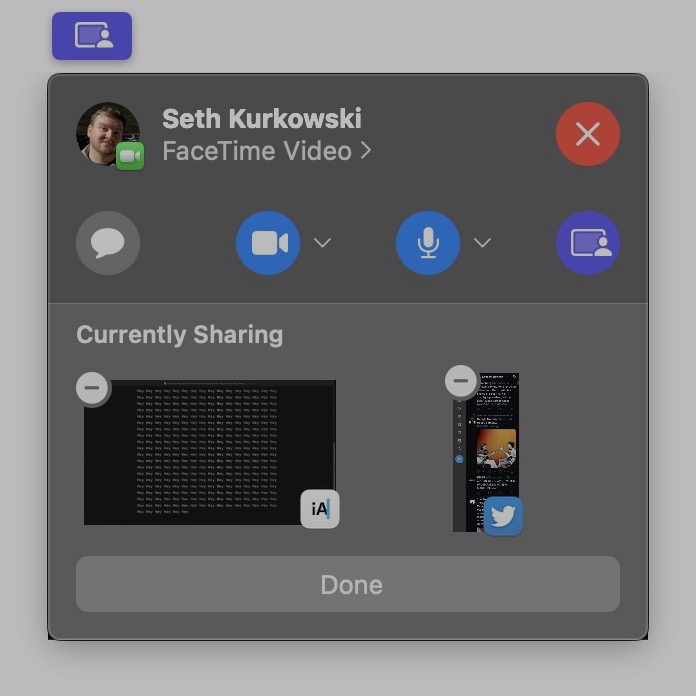
macOS Sequoia still lets you share your entire screen if you want. However, you can also select which active apps or specific windows of apps are included when screen sharing. You can even toggle this as you share your screen. That means you can add or remove shared windows and apps as needed.
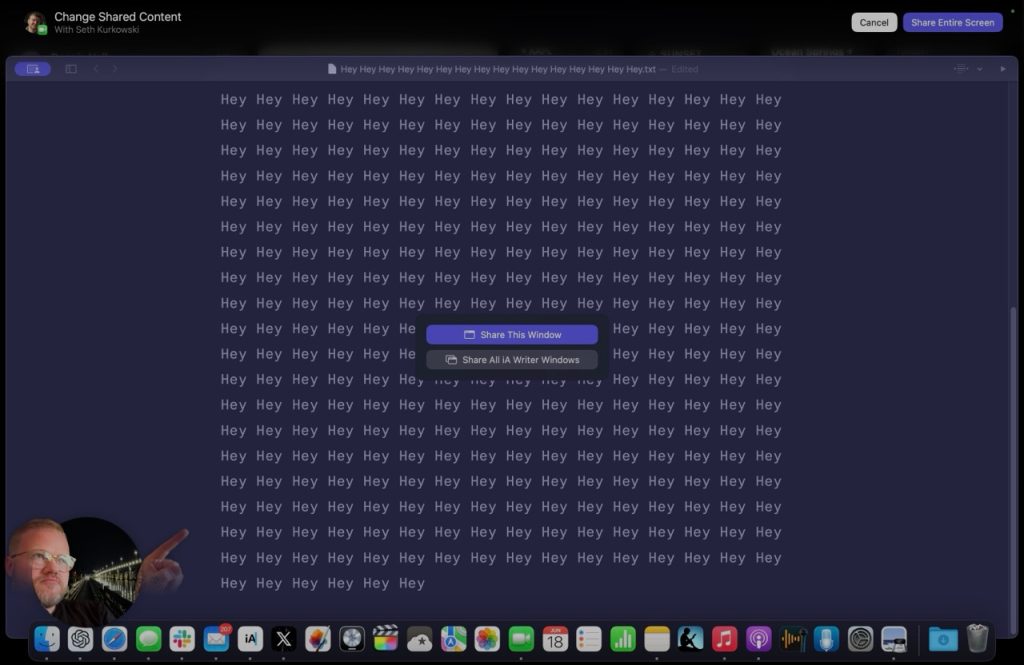
Background replacements
Then there’s the new background replacements feature. The Mac has long had a sort of toy version of this feature specific to Photo Booth. This time around, however, it’s a modern implementation that’s fit for professional usage.
Apple uses what they call their “industry-leading segmentation” to pull it off. Translation? You just might want to use Apple’s background replacements feature over the built-in version on Zoom and WebEx. Better yet, it also brings background replacements to FaceTime for the first time.
You can access background replacements in the video controller panel in the menu bar. From there, the new “Background” section lets you toggle the feature on or off, assign your own custom background, or select from a variety of gradients and backgrounds.

Apple’s version has a few nice perks in addition to just being reliable. First, you can apply other video enhancements like portrait background blur and studio lighting to your custom background and yourself. Second, background replacements are consistent between calls. That means you don’t need to configure the feature each time you want to use your preferred background.
If you do decide to switch your background for different scenarios, the video controller panel puts the options right at your fingertips with any compatible video calling app. Lastly, these backgrounds are compatible with the existing presenter mode view!
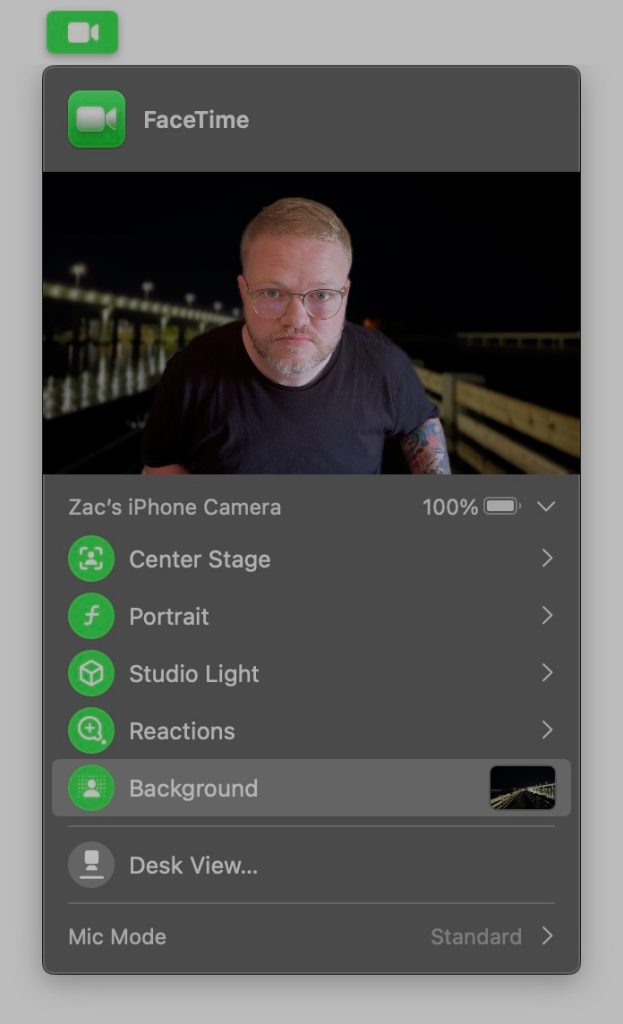
Presenter preview is an especially welcome enhancement to screen sharing on macOS Sequoia. This feature should save presenters from accidentally oversharing on future video calls.
Background replacements, on the other hand, is similar to features widely available in most video calling apps — except FaceTime.
Starting with macOS Sequoia, FaceTime will gain this common feature, joining the existing background blur portrait feature. Meanwhile, system integration will give Mac users the option to use a single implementation of background replacements across video calling apps — likely with better results to boot.
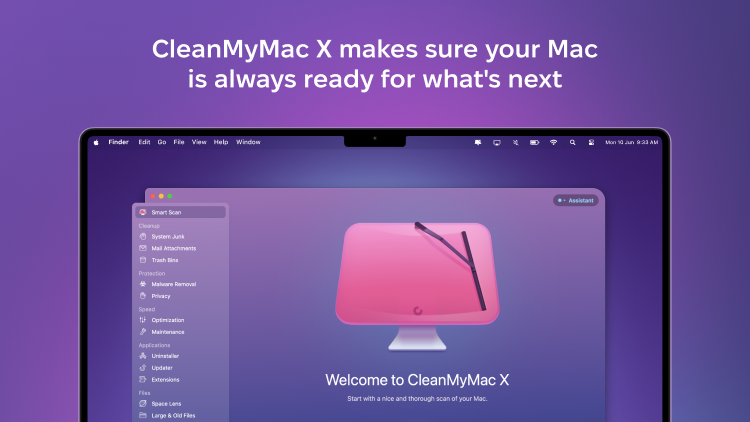
FTC: We use income earning auto affiliate links. More.

Check out 9to5Mac on YouTube for more Apple news:

Zac covers Apple news, hosts the 9to5Mac Happy Hour podcast, and created SpaceExplored.com.
- Get Benzinga Pro
- Data & APIs
- Our Services
- News Earnings Guidance Dividends M&A Buybacks Legal Interviews Management Offerings IPOs Insider Trades Biotech/FDA Politics Government Healthcare
- Markets Pre-Market After Hours Movers ETFs Forex Cannabis Commodities Binary Options Bonds Futures CME Group Global Economics Mining Previews Small-Cap Real Estate Cryptocurrency Penny Stocks Digital Securities Volatility
- Ratings Analyst Color Downgrades Upgrades Initiations Price Target
- Ideas Trade Ideas Long Ideas Short Ideas Technicals From The Press Jim Cramer Rumors Best Stocks & ETFs Best Penny Stocks Best S&P 500 ETFs Best Swing Trade Stocks Best Blue Chip Stocks Best High-Volume Penny Stocks Best Small Cap ETFs Best Stocks to Day Trade Best REITs
- Money Investing Cryptocurrency Mortgage Insurance Yield Personal Finance Forex Startup Investing Real Estate Investing Credit Cards
- Cannabis Cannabis Conference News Earnings Interviews Deals Regulations Psychedelics
Now Make Apple-Style Presentations Using Just Your Phone Or Webcam, Thanks To This Nvidia-Backed AI Startup
Synthesia , a British AI startup, has unveiled new product updates, including the ability to create AI avatar presentations using just a laptop webcam or a phone. This development is part of the company’s strategy to become a comprehensive video production suite for large companies.
What Happened : Synthesia, a seven-year-old company backed by Nvidia Corp. NVDA , has introduced a range of new features to its platform, CNBC reported on Monday.
In a presentation reminiscent of Apple Inc.’s keynotes, Synthesia’s CEO unveiled the company’s latest products, highlighting their focus on enhancing business productivity beyond just providing AI avatars.
These new features include the ability to create AI avatars using webcams or phones, “full body” avatars with hands and arms, and a screen recording tool with an AI avatar guiding users through the content.
Among the most notable features showcased was the ability to create AI-generated avatars with less than five minutes of footage captured via a webcam or smartphone. Additionally, users can clone their voices, enabling the avatars to speak in multiple languages.
The company, whose services are reportedly used by nearly half of the Fortune 500 companies, is now enabling users to create AI avatars for various purposes, such as customized training videos and promotional materials.
According to Synthesia’s co-founder and CEO, Victor Riparbelli , the company initially targeted Hollywood agencies and high-budget video production firms. However, it later shifted its focus to democratizing video creation for millions of people who lack the budget for traditional video production.
See Also: Nvidia’s Brand Recognition Lags Behind Apple, Microsoft Despite Leading AI Revolution And Market Cap
Last year, Synthesia raised $90 million from investors, including U.S. chipmaker Nvidia and venture capital firm Accel , in a funding round that valued the company at $1 billion, earning it “unicorn” status.
Why It Matters : Synthesia’s competitors include AI video tools like Veed , Colossyan , Elai , and HeyGen . Additionally, the Chinese-owned social media app TikTok recently introduced Symphony Assistant, a product that allows creators to make their own AI avatars.
The company generates revenue through various subscription pricing plans, ranging from $22 for a “Starter” plan and $67 for the “Creator” plan to custom “Enterprise” plans with pricing based on negotiations with Synthesia's sales team, according to the report.
For Nvidia, this development underscores the company’s continued investment in and support of AI technology. Nvidia’s CEO, Jensen Huang , recently highlighted the company’s significant investments in deep learning and the resulting AI revolution.
Read Next: Donald Trump Vows To End ‘Joe Biden’s War On Crypto,’ Shiba Inu’s Burn Rate Surges, TrumpCoin Mystery And More
Image Via Pixabay
This story was generated using Benzinga Neuro and edited by Kaustubh Bagalkote
© 2024 Benzinga.com. Benzinga does not provide investment advice. All rights reserved.
Trade confidently with insights and alerts from analyst ratings, free reports and breaking news that affects the stocks you care about.


Get started with Copilot for Microsoft 365 in Teams
Copilot works alongside you to bring together data from your documents, presentations, email, calendar, notes, and contacts in Microsoft Teams. Find and use info that's buried in documents or lost in conversations, and get things done in whole new ways using the power of AI.
Go to Chat on the left side of Teams.
Select Copilot from the top of your Teams chat list.
In the Copilot chat, type your prompt. For example, "Summarize my recent unread messages from [a person]."
Select Send .
Once Copilot generates a response, select the sources to understand how the response was cited. AI-generated content may be incorrect, so sources are provided for your review when possible.
Here are some suggestions for prompts you might want to try. Copy them or modify them to suit your needs.
What happened in my last meeting?
Catch up on unread chats.
Draft a message that OKRs are due next week.
Tell my team how we updated the product strategy.
Summarize the chats, emails, and documents about the [a customer] escalation that happened last night.
What is the next milestone on [a project]. Are there any risks? Help me brainstorm a list of some potential mitigations.
Write a planning overview in the style of [a file] that contains the timeline from [a different file] and incorporates the project list in the email from [a person].
Related topics
Overview: Copilot in Microsoft Teams
Get started with Copilot in Microsoft Teams chat
Get started with Copilot in Microsoft Teams meetings
Frequently asked questions about Copilot in Microsoft Teams

Need more help?
Want more options.
Explore subscription benefits, browse training courses, learn how to secure your device, and more.

Microsoft 365 subscription benefits

Microsoft 365 training

Microsoft security

Accessibility center
Communities help you ask and answer questions, give feedback, and hear from experts with rich knowledge.

Ask the Microsoft Community

Microsoft Tech Community

Windows Insiders
Microsoft 365 Insiders
Find solutions to common problems or get help from a support agent.

Online support
Was this information helpful?
Thank you for your feedback.
Keynote User Guide for Mac
- What’s new in Keynote 14.1
- Intro to Keynote
- Intro to images, charts, and other objects
- Create a presentation
- Choose how to navigate your presentation
- Open or close a presentation
- Save and name a presentation
- Find a presentation
- Print a presentation
- Undo or redo changes
- Show or hide sidebars
- Quick navigation
- Change the working view
- Expand and zoom your workspace
- Customize the Keynote toolbar
- Change Keynote settings on Mac
- Touch Bar for Keynote
- Create a presentation using VoiceOver
- Add or delete slides
- Add and view presenter notes
- Reorder slides
- Group or ungroup slides
- Skip or unskip a slide
- Change the slide size
- Change a slide background
- Add a border around a slide
- Show or hide text placeholders
- Show or hide slide numbers
- Apply a slide layout
- Add and edit slide layouts
- Change a theme
- Add an image
- Add an image gallery
- Edit an image
- Add and edit a shape
- Combine or break apart shapes
- Draw a shape
- Save a shape to the shapes library
- Add and align text inside a shape
- Add 3D objects
- Add lines and arrows
- Animate, share, or save drawings
- Add video and audio
- Record audio
- Edit video and audio
- Add live video
- Set movie and image formats
- Position and align objects
- Use alignment guides
- Place objects inside a text box or shape
- Layer, group, and lock objects
- Change object transparency
- Fill shapes and text boxes with color or an image
- Add a border to an object
- Add a caption or title
- Add a reflection or shadow
- Use object styles
- Resize, rotate, and flip objects
- Move and edit objects using the object list
- Add linked objects to make your presentation interactive
- Select text
- Copy and paste text
- Use dictation to enter text
- Use accents and special characters
- Format a presentation for another language
- Use phonetic guides
- Use bidirectional text
- Use vertical text
- Change the font or font size
- Add bold, italic, underline, or strikethrough to text
- Change the color of text
- Change text capitalization
- Add a shadow or outline to text
- Intro to paragraph styles
- Apply a paragraph style
- Create, rename, or delete paragraph styles
- Update or revert a paragraph style
- Use a keyboard shortcut to apply a style
- Adjust character spacing
- Add drop caps
- Raise and lower characters and text
- Format fractions automatically
- Create and use character styles
- Format dashes and quotation marks
- Format Chinese, Japanese, or Korean text
- Set tab stops
- Format text into columns
- Adjust line spacing
- Format lists
- Add a highlight effect to text
- Add mathematical equations
- Add borders and rules (lines) to separate text
- Add or delete a table
- Select tables, cells, rows, and columns
- Add or remove rows and columns
- Move rows and columns
- Resize rows and columns
- Merge or unmerge cells
- Change the look of table text
- Show, hide, or edit a table title
- Change table gridlines and colors
- Use table styles
- Resize, move, or lock a table
- Add and edit cell content
- Format dates, currency, and more
- Create a custom cell format
- Highlight cells conditionally
- Format tables for bidirectional text
- Alphabetize or sort table data
- Calculate values using data in table cells
- Use the Formulas and Functions Help
- Add or delete a chart
- Change a chart from one type to another
- Modify chart data
- Move, resize, and rotate a chart
- Change the look of data series
- Add a legend, gridlines, and other markings
- Change the look of chart text and labels
- Add a chart border and background
- Use chart styles
- Animate objects onto and off a slide
- Animate objects on a slide
- Change build order and timing
- Add transitions
- Present on your Mac
- Present on a separate display
- Present on a Mac over the internet
- Use a remote
- Make a presentation advance automatically
- Require a password to exit a presentation
- Play a slideshow with multiple presenters
- Rehearse on your Mac
- Record presentations
- Check spelling
- Look up words
- Find and replace text
- Replace text automatically
- Set author name and comment color
- Highlight text
- Add and print comments
- Send a presentation
- Intro to collaboration
- Invite others to collaborate
- Collaborate on a shared presentation
- See the latest activity in a shared presentation
- Change a shared presentation’s settings
- Stop sharing a presentation
- Shared folders and collaboration
- Use Box to collaborate
- Create an animated GIF
- Post your presentation in a blog
- Use iCloud Drive with Keynote
- Export to PowerPoint or another file format
- Reduce the presentation file size
- Save a large presentation as a package file
- Restore an earlier version of a presentation
- Move a presentation
- Delete a presentation
- Password-protect a presentation
- Lock a presentation
- Create and manage custom themes
- Transfer files with AirDrop
- Transfer presentations with Handoff
- Transfer presentations with the Finder
- Keyboard shortcuts
- Keyboard shortcut symbols
Record Keynote presentations on Mac
You can record a presentation with voiceover narration on your Mac to play later in Keynote or export as a video file. This is especially useful when you want to distribute or present a prerecorded presentation virtually, or if you want to record a slideshow for someone to play in your absence.
Record a presentation
Open the presentation, then click to select the first slide in the slide navigator .
Choose Play > Record Slideshow (from the Play menu at the top of your screen). The presenter display appears with recording controls visible at the bottom of your screen.
Move an item on the presenter display: Drag it.
When you drag a slide, its label always moves with it. To position a label independently of the slide, drag only the label. To drag multiple items simultaneously, Command-click or Shift-click to select them, then drag.
Resize an item on the presenter display: Click the item, then drag any selection handle.
The clock, timer, and labels are always resized proportionally from their centers.
To maintain the proportions as you resize a slide, the Presenter Notes field, or the Ready to Advance Indicator, hold down Shift as you drag. To resize from the center, hold down Option as you drag. To proportionally resize from the center, hold down Shift and Option as you drag.
Automatically position the items on the presenter display: Click the Use Auto Layout button. Keynote positions the items to make optimal use of the presenter display.
Change the appearance of presenter notes: With presenter notes showing, move the pointer over the Presenter Notes field, then click a font button in the top-left corner to make the font smaller or larger. Click the Invert Colors button to show white text on a black background or vice versa (other text colors aren’t affected).
The timer counts down from 3 before recording begins.
Do any of the following while recording the presentation:
Go to the next slide or build: Press the Right Arrow key.
Go back a slide or reset the builds on the slide: Press the Left Arrow key.
Jump to a different slide: Press any number to make the slide navigator appear, enter the slide number, then press Return.
Open or close a list of keyboard shortcuts: Press the Question Mark (?) key on your keyboard. You can use the shortcuts to control your presentation.
To edit the recording, do one of the following:
Press Esc to exit the presenter display.
The recording is saved with your presentation and can be played in Keynote. To export a recorded presentation as a video or another file format, see Export to PowerPoint or another file format .
To remove a recording from your Keynote presentation, choose Play > Clear Recording, then select Clear in the pop-up menu.
Play a recorded presentation in Keynote on Mac
With the presentation open, do one of the following:
Play a recorded presentation in full screen: Choose Play > In Fullscreen.
Play a recorded presentation in a window: Choose Play > In Window.
To stop playing the slideshow, press Esc.

IMAGES
VIDEO
COMMENTS
Step 2: Open PowerPoint. Open PowerPoint and choose a template or open a blank presentation. PowerPoint offers a variety of templates to suit different presentation styles. If you choose to start with a blank slate, you'll have complete creative freedom.
To play the presentation, click in the toolbar, then press the arrow keys to advance through the slides. To end the presentation, press the Esc (Escape) key. For more ways to show a presentation, see Play a presentation on your Mac. To close the presentation, click the red close button in the top-left corner of the window.
Short Answer. Making a PowerPoint on a Mac is easy. First, open up the Pages application on your Mac. Then, select the File menu and choose New from Template. From there, you can select a PowerPoint template and customize it to fit your needs. When you are finished, you can save your presentation and share it with others.
You can play your presentation on your Mac whenever you want to preview it yourself, or when you're ready to deliver it to an audience. There are two ways to play a Keynote presentation on your Mac: Present in full screen: Shows the current slide on your primary display while the presenter display, with your notes and controls, is hidden.
Support app. Get personalized access to solutions for your Apple products. Download the Apple Support app. Learn more about creating, editing, saving, and sharing presentations on your Mac, iPad, iPhone, iPod touch, and on the web. Learn more with these Keynote resources.
Whether you need to show off your school project, business plan, or family vacation photos, PowerPoint is your go-to app for presentations. Kickstart your creativity. • Achieve more and enhance your documents with access to a growing catalog of premium templates for Word, Excel, and PowerPoint. • Advanced formatting and layout options ...
Here are four steps you can take to learn how to use Keynote to make a presentation. 1. Explore the Keynote App Interface. If you're switching to the Keynote app from another piece of presentation software, my favorite tip is to spend time familiarizing yourself with the interface.
Apply or change slide layouts. Customize a slide master. Change the page orientation of your PowerPoint presentation. Create and use your own presentation template. Create your own theme in PowerPoint. Learn about SmartArt graphics. Compress the picture size. Crop a picture. Add a transparent picture (watermark) to your slides.
Here's how. In Keynote, click on the File menu and move your cursor to "Export to". A pop-up menu will appear. Select PowerPoint. IDG. In the Export Your Presentation window that appears ...
How to Make a PowerPoint Presentation on a Mac. Part of the series: Using Apple Computers. Making a PowerPoint presentation on a Mac computer can be done usi...
To convert PowerPoint to video on a Mac, open the presentation you want to save and select File > Export. In the export window, next to File Format, select a file format option, such as MP4 or MOV. Choose your video quality, choose whether you want to include narrations, adjust timing, and select Export.
Presenting while on a video conference is easier than ever. With Keynote, you can share your presentation and your presenter notes will appear in a separate ...
PowerPoint 2021 for Mac lets you create compelling content with the addition of features including co-authoring, Ink Replay, better support for SVG, and more rich media content from the Office Premium Creative Content collection. If you're upgrading to PowerPoint 2021 for Mac from PowerPoint 2019 for Mac, you'll still have all the features you ...
Ensure that you build your pitch decks with less text and more graphics. Keeping the slide content simple and precise will bestow your MAC slideshow with a decluttered look. It will help you to further your brand aesthetics as well. You may consider following the famous 10-20-30 rule of PowerPoint presentations.
Click File in the menu bar and navigate to Create > Slideshow > Photos. A new window will appear. Select New Slideshow from the dropdown and give the slideshow a name. Then, click OK. Select the photos you want to include in the slideshow and click the Add button in the top-right corner.
1. Launch the App Store on your Mac computer. 2. In the search bar on the left, type in "PowerPoint." Search for "PowerPoint" in the textbox located at the top of the App Store screen. Meira Gebel ...
This is achieved through the Send a Copy feature. Tap the Presentations option in the top left corner to take you back to the main Keynote menu. Here you'll see all your files. In the upper ...
On your Mac, choose Apple menu > System Settings (or System Preferences in macOS 12 or earlier), then click Notifications (you may need to scroll down). In Keynote on Mac, connect to an external display, a projector, or an Apple TV with AirPlay to show your presentation on a separate display.
Next, click on the AirPlay icon in your menu bar and choose your preferred option under the Use AirPlay Display To label. Selecting Extend Desktop is recommended, as this will enable second-screen views like Keynote's Presenter View while still showing your presentation as normal on the external display or projector.
ANNOTATION. - You can draw on or annotate any screen you wish. Select `Annotate Screen` from the menu bar and start doodling. - A lot of drawing shapes to choose from. You can even write Text now. - Draw with random gradient colors instead of just plain colors. - Auto-erase your annotations. Perfect for emphasizing something specific or ...
Mac + Powerpoint. Using Powerpoint Presenter View for speakers on Corporate Events. When a presenter shows their Powerpoint-presentation from a stage or a studio, they usually want to see the presenter-view while they are talking. Here they can see their slides and presenter-notes. The presenter-view in Powerpoint for mac.
keynote not printing a handout of my presentation - help please I am using Keynote 12.1 and can't get the printer to show "choose Keynote" in order to print a handout of my presentations. ( I used to do this in MS Powerpoint and it was quite easy.)
CUPERTINO, CALIFORNIA Apple today introduced Apple Intelligence, the personal intelligence system for iPhone, iPad, and Mac that combines the power of generative models with personal context to deliver intelligence that's incredibly useful and relevant.Apple Intelligence is deeply integrated into iOS 18, iPadOS 18, and macOS Sequoia. It harnesses the power of Apple silicon to understand and ...
To control the presentation, do any of the following: Advance to the next slide or build: Tap the slide, or swipe left across the slide. Return to the previous slide: Swipe right across the slide. Skip to a specific slide: Tap the slide number in the upper-left corner, then tap the slide you want to display. Stop playing the presentation: Tap . To change what you see on your remote device as ...
Now, open the presentation PPT and locate the slide you want to record. Step 6. Click Record to start recording slide about yourself. Step 7. To stop recording in PPT, the Stop button. Way 2. Try another presentation recorder - EaseUS RecExperts for Mac. To record presentation with face and audio directly, you can use a Mac screen recorder ...
While Apple Intelligence may be the biggest change landing on the Mac this fall, macOS Sequoia includes a handful of other new features. Two features specific to video conferencing, presenter ...
In a presentation reminiscent Apple Inc.'s keynotes, Synthesia's CEO unveiled the company's latest products, highlighting their focus on enhancing business productivity beyond just providing ...
Copilot works alongside you to bring together data from your documents, presentations, email, calendar, notes, and contacts in Microsoft Teams. Find and use info that's buried in documents or lost in conversations, and get things done in whole new ways using the power of AI. Go to Chat on the left side of Teams.
Record Keynote presentations on Mac. You can record a presentation with voiceover narration on your Mac to play later in Keynote or export as a video file. This is especially useful when you want to distribute or present a prerecorded presentation virtually, or if you want to record a slideshow for someone to play in your absence.
Read more: Despite My Hesitation, Apple's WWDC Presentation Made Me Excited for iOS 18. ... Also, when Apple released iOS 16.6 in July 2023 -- the last major iOS 16 update prior to the release of ...